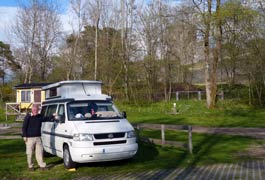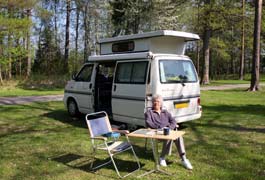|
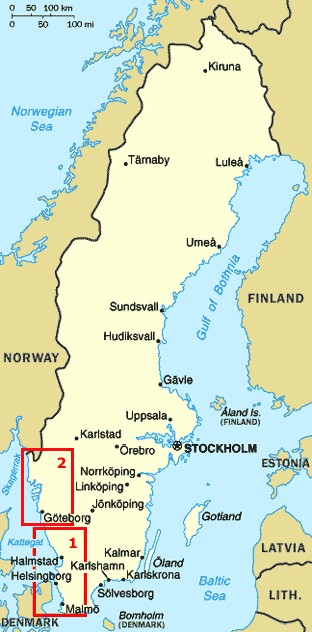 CAMPING
IN SWEDEN 2013 - Skåne, Göteborg, the Bohuslän Coast, and inland to Trollhättan, Lake Vänern
and Dalsland: CAMPING
IN SWEDEN 2013 - Skåne, Göteborg, the Bohuslän Coast, and inland to Trollhättan, Lake Vänern
and Dalsland:
Despite DFDS' monopolistic prices, we again
this year crossed the North Sea using their Harwich\Esbjerg service to Denmark (Photo 1 - Ferry entering Esbjerg harbour); a newspaper headline in the ferry's shop gave symbolic
representation of why we were again thankful to be saying farewell to UK for a
while: Commons Deputy Speaker arrested on charges of gay rape (sic!). An
afternoon's drive brought us the width of Denmark's 3 main islands across the
spectacular bridges (Photo 2 - Crossing the Store Bælt Bridge) and that
first evening we finally crossed the Öresund Bridge for our first camp in this
year's host country near to Lomma just north of Malmö, with the song of this
year's first cuckoo echoing around the shore-side campsite and supper looking out to
a glowing sunset across the Öresund (Photo
3 - Sunset over the Öresund).
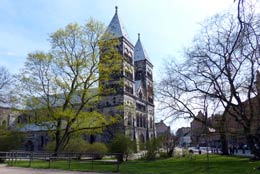 University and Cathedral city of Lund:
on a serenely sunny Spring morning, we drove
into nearby Lund; experience of finding a parking place taught us an essential
Swedish word avgift meaning charge or payment by the hour. Lund is
Sweden's 2nd oldest city founded by the Danish-Viking King Sven Tveskägg (Forkbeard)
in 990 AD and is now a lively university town with racks of students' bicycles lining the
main square of Stortorget (Photo 4 - Lund's main square, Stortorget). We
spent a happy morning ambling around the flower and vegetable market,
lunching in the market-hall and visiting the excavated subterranean remains of
Lund's medieval churches. Along Kyrkogatan we reached the twin-towered
Cathedral, the Domkyrkan built in the 12th century when Lund became
Scandinavia's first independent archbishopric (see left). University and Cathedral city of Lund:
on a serenely sunny Spring morning, we drove
into nearby Lund; experience of finding a parking place taught us an essential
Swedish word avgift meaning charge or payment by the hour. Lund is
Sweden's 2nd oldest city founded by the Danish-Viking King Sven Tveskägg (Forkbeard)
in 990 AD and is now a lively university town with racks of students' bicycles lining the
main square of Stortorget (Photo 4 - Lund's main square, Stortorget). We
spent a happy morning ambling around the flower and vegetable market,
lunching in the market-hall and visiting the excavated subterranean remains of
Lund's medieval churches. Along Kyrkogatan we reached the twin-towered
Cathedral, the Domkyrkan built in the 12th century when Lund became
Scandinavia's first independent archbishopric (see left).
|
Click on 2 highlighted areas of map for
details of
SW Sweden |
 |
 The interior with its sturdy
Romanesque rounded arches is dominated by the chancel's huge apse whose dome is
decorated with gilded mosaics of Christ in Glory (Photo 5 - Lund Cathedral apse with gilded mosaics).
Down in the gloomy crypt, 2 of the pillars supporting the chancel above are
gripped by stone figures: the legend is that Finn the Giant built the cathedral
for St Lawrence demanding the saint's eyes in payment unless the saint could
guess his name. The canny saint however overheard the giant's wife boast to her
child of Father Finn's gift of eyes to play with; the giant, his wife and child rushed into
the crypt to pull down the columns but were turned to stone. It's a good yarn,
and they are still they to be seen clutching the pillars. Up in the nave, the 1440s
astronomical clock with its complex of dials plays In Dulce
Jubilo as the clock strikes 3-00 and a procession of Wise Men carved figures parades around
the Virgin and Child. The interior with its sturdy
Romanesque rounded arches is dominated by the chancel's huge apse whose dome is
decorated with gilded mosaics of Christ in Glory (Photo 5 - Lund Cathedral apse with gilded mosaics).
Down in the gloomy crypt, 2 of the pillars supporting the chancel above are
gripped by stone figures: the legend is that Finn the Giant built the cathedral
for St Lawrence demanding the saint's eyes in payment unless the saint could
guess his name. The canny saint however overheard the giant's wife boast to her
child of Father Finn's gift of eyes to play with; the giant, his wife and child rushed into
the crypt to pull down the columns but were turned to stone. It's a good yarn,
and they are still they to be seen clutching the pillars. Up in the nave, the 1440s
astronomical clock with its complex of dials plays In Dulce
Jubilo as the clock strikes 3-00 and a procession of Wise Men carved figures parades around
the Virgin and Child.
Outside
in the Lundagård university park, students sat on the grass in the sunshine (see
left), as
we walked through to the beautiful botanical gardens of the Universitets platsen,
with the magnolias now in full bloom and the glorious classically styled
Universitets huset forming a backdrop to the grand central fountain (Photo 6 - Main building and gardens of Lund University).
Lund University
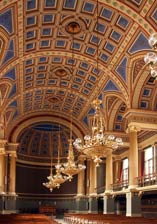 was founded in 1666 after the 1658 crucial Treaty of Roskilde
had finally ceded the SW corner of the country to Sweden from Danish control.
The university developed in the 19th century with the establishment of new
Chairs, an increase in student numbers and women admitted as early as the 1880s. In 1900
there were 1000 students at Lund; today it is one of Scandinavia's largest
institutions of higher education and research with over 47,000 students. Inside
the university building we were able to get a look at the magnificent
assembly aula where degree ceremonies are held (see left). was founded in 1666 after the 1658 crucial Treaty of Roskilde
had finally ceded the SW corner of the country to Sweden from Danish control.
The university developed in the 19th century with the establishment of new
Chairs, an increase in student numbers and women admitted as early as the 1880s. In 1900
there were 1000 students at Lund; today it is one of Scandinavia's largest
institutions of higher education and research with over 47,000 students. Inside
the university building we were able to get a look at the magnificent
assembly aula where degree ceremonies are held (see left).
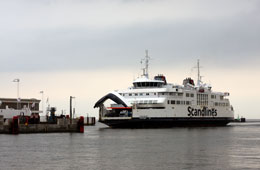 Helsingborg, port for cross-Öresund ferries: 30kms north we reached
the industrial port of Helsingborg planning to stay at Råå Vallar Camping, yet
another wretched holiday-camp where we were greeted in an unwelcoming and
officious manner: it was one of those places with so many offensively
restrictive regulations, you did not know which one to break first, an expensive
and inhospitable place to be avoided. The following morning we drove down to the harbour from where
ferries chug back and forth across the Öresund carrying Swedes across to
Helsingør on the Danish side to buy cheaper alcohol (see right). But today the
Danish shore was scarcely visible in miserable misty rain.
We sat by the yacht marina looking across to Helsingborg's Kulturhus, the city
Museum and Art Gallery designed by Kim Utzon, son of the Sydney Opera House
architect, but a rather less inspiring design. The Kulturhus was funded by the
foundation set up by Henry Dunkers, a Helsingborg industrialist who made his
fortune by perfecting the vulcanising process to make rubber boots, manufactured at the
Helsingborg Gummifabrik. The factory closed in 1979 but the name lives on in the
modernistic building by the city's waterfront. Rather more imposing is the
city's pompously Neo-Gothic Rådhus (town hall) which dominates the corner Helsingborg, port for cross-Öresund ferries: 30kms north we reached
the industrial port of Helsingborg planning to stay at Råå Vallar Camping, yet
another wretched holiday-camp where we were greeted in an unwelcoming and
officious manner: it was one of those places with so many offensively
restrictive regulations, you did not know which one to break first, an expensive
and inhospitable place to be avoided. The following morning we drove down to the harbour from where
ferries chug back and forth across the Öresund carrying Swedes across to
Helsingør on the Danish side to buy cheaper alcohol (see right). But today the
Danish shore was scarcely visible in miserable misty rain.
We sat by the yacht marina looking across to Helsingborg's Kulturhus, the city
Museum and Art Gallery designed by Kim Utzon, son of the Sydney Opera House
architect, but a rather less inspiring design. The Kulturhus was funded by the
foundation set up by Henry Dunkers, a Helsingborg industrialist who made his
fortune by perfecting the vulcanising process to make rubber boots, manufactured at the
Helsingborg Gummifabrik. The factory closed in 1979 but the name lives on in the
modernistic building by the city's waterfront. Rather more imposing is the
city's pompously Neo-Gothic Rådhus (town hall) which dominates the corner
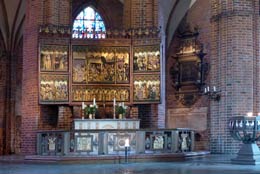 opposite the ferry harbour (Photo 7 - Waterfront and Rådhus at Helsingborg).
The elongated main square of Stortorget leads uphill from the port to the
remains of Helsingborg's medieval castle, fought over for centuries until Sweden
finally gained control of Skåne from the Danes. The surviving castle keep of
Kärnan now serves as a landmark for mariners passing along the Öresund and
provides spectacular views down to the ferry harbour,
at least on a clear day which today wasn't! (Photo 8 - Öresund ferry from Helsinør entering Helsingborg harbour).
From the parklands surrounding Kärnan, a pathway lined with rhododendrons leads
down to Södra Storgatan in the old town and the Danish-Gothic basilica of Sancta
Maria kyrka. The red-brick 14th century church's plain exterior gives little
impression of its beautiful interior. Amid the imposing brick-archwork, the eye
is drawn to the gilded 1450 carved triptych, its 3 panels depicting scenes from
the life of Christ (see left). opposite the ferry harbour (Photo 7 - Waterfront and Rådhus at Helsingborg).
The elongated main square of Stortorget leads uphill from the port to the
remains of Helsingborg's medieval castle, fought over for centuries until Sweden
finally gained control of Skåne from the Danes. The surviving castle keep of
Kärnan now serves as a landmark for mariners passing along the Öresund and
provides spectacular views down to the ferry harbour,
at least on a clear day which today wasn't! (Photo 8 - Öresund ferry from Helsinør entering Helsingborg harbour).
From the parklands surrounding Kärnan, a pathway lined with rhododendrons leads
down to Södra Storgatan in the old town and the Danish-Gothic basilica of Sancta
Maria kyrka. The red-brick 14th century church's plain exterior gives little
impression of its beautiful interior. Amid the imposing brick-archwork, the eye
is drawn to the gilded 1450 carved triptych, its 3 panels depicting scenes from
the life of Christ (see left).
 Kullaberg Peninsula Nature Reserve:
rising conspicuously above the flat surrounding farmland, the high wooded ridge
of the Kullaberg Peninsula was our next stop with a stay at First Camp
Möllehässle; despite the high price at what was another large holiday-camp, the
setting was pleasant with flat pitches terraced into the grassy slopes and more
importantly, a hospitable welcome; what a difference a smile makes! That evening
we enjoyed the trip's first barbecue (see right). Our reason however for coming here was a day's walking around the Kullaberg Nature
Reserve's cliff-top paths of the peninsula which projects into the Kattegat. Kullaberg Peninsula Nature Reserve:
rising conspicuously above the flat surrounding farmland, the high wooded ridge
of the Kullaberg Peninsula was our next stop with a stay at First Camp
Möllehässle; despite the high price at what was another large holiday-camp, the
setting was pleasant with flat pitches terraced into the grassy slopes and more
importantly, a hospitable welcome; what a difference a smile makes! That evening
we enjoyed the trip's first barbecue (see right). Our reason however for coming here was a day's walking around the Kullaberg Nature
Reserve's cliff-top paths of the peninsula which projects into the Kattegat.
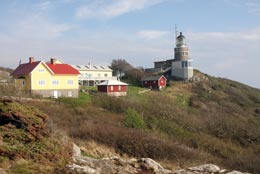 Parking by the lighthouse at the tip of the peninsula, we set off around the
woodland path and were soon down on hands and knees photographing the banks of Spring wild flora, most
noticeably wood anemones (Photo 9 - Banks of
Wood Anemones at Kullaberg Nature Reserve).
Kullaberg's distinctive peninsula is an ancient east-west ridge of
erosion-resistant gneiss bedrock formed by the surrounding softer red sandstone
being eroded away and criss-crossed with fissure ravines along the coastlines.
The path undulated through the delightful birch woodland with occasional
glimpses of the sheer rocky cliffs. Across to the southern coastline among tall
birch trees whose bright green new leaf glowed in the sunlight, the return path
passed over more open heathland back to the lighthouse (see left) where the rocks at the
peninsula's tip gave misty views out across the Kattegat (Photo 10 - Misty Kattegat vista
from Kullaberg lighthouse). Parking by the lighthouse at the tip of the peninsula, we set off around the
woodland path and were soon down on hands and knees photographing the banks of Spring wild flora, most
noticeably wood anemones (Photo 9 - Banks of
Wood Anemones at Kullaberg Nature Reserve).
Kullaberg's distinctive peninsula is an ancient east-west ridge of
erosion-resistant gneiss bedrock formed by the surrounding softer red sandstone
being eroded away and criss-crossed with fissure ravines along the coastlines.
The path undulated through the delightful birch woodland with occasional
glimpses of the sheer rocky cliffs. Across to the southern coastline among tall
birch trees whose bright green new leaf glowed in the sunlight, the return path
passed over more open heathland back to the lighthouse (see left) where the rocks at the
peninsula's tip gave misty views out across the Kattegat (Photo 10 - Misty Kattegat vista
from Kullaberg lighthouse).
So pleasing were the wild flora during these
first 3 weeks that we have included a photo-gallery of
Spring flora of SW Sweden
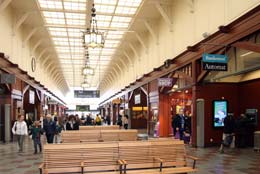 Göteborg,
Sweden's second city: a 200km drive up the E6 motorway brought us to
Sweden's second city, Göteborg (pronounced Yerteboy). The city's only
campsites are both run by the horrendous Liseberg Amusement Park, both of them huge
holiday-camps charging outrageously extortionate prices for the dubious
privilege of staying there. We did however want to visit Göteborg and chose the
marginally lower priced Askim Strand Camping some 12kms out of the city down at
the coast. The young staff however were welcoming and helpful, giving us
details of the Rosa Express buses into the city centre and the bus stop 15
minutes walk away. The following morning, we set off to catch the bus,
following the journey on the street plan we had been given to get off at the
city's Central Railway Station. Göteborg was
founded at the mouth of the Göta River in 1621 by King Gustav II Adolphus. With
the South-West of the country securely in Swedish control from the Danes after
1658, the port-city developed as a major trading post bypassing the extortionate Öresund tolls charged by the Danish and so attracting British, Dutch and German
merchants. In the 18/19th centuries it Göteborg,
Sweden's second city: a 200km drive up the E6 motorway brought us to
Sweden's second city, Göteborg (pronounced Yerteboy). The city's only
campsites are both run by the horrendous Liseberg Amusement Park, both of them huge
holiday-camps charging outrageously extortionate prices for the dubious
privilege of staying there. We did however want to visit Göteborg and chose the
marginally lower priced Askim Strand Camping some 12kms out of the city down at
the coast. The young staff however were welcoming and helpful, giving us
details of the Rosa Express buses into the city centre and the bus stop 15
minutes walk away. The following morning, we set off to catch the bus,
following the journey on the street plan we had been given to get off at the
city's Central Railway Station. Göteborg was
founded at the mouth of the Göta River in 1621 by King Gustav II Adolphus. With
the South-West of the country securely in Swedish control from the Danes after
1658, the port-city developed as a major trading post bypassing the extortionate Öresund tolls charged by the Danish and so attracting British, Dutch and German
merchants. In the 18/19th centuries it
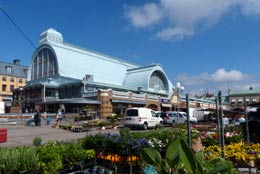 became the base for Swedish trade with
the Far East monopolised by the Swedish East India Company, and continues as a
major cosmopolitan port-city today with a population of over 500,000. became the base for Swedish trade with
the Far East monopolised by the Swedish East India Company, and continues as a
major cosmopolitan port-city today with a population of over 500,000.
We quickly got our bearing and began our walk around the city at the Central
Station whose surviving period façade reflects its 1856 foundation, the
country's oldest railway station, with stylish ticket hall to match (see right).
In the brashly garish Nordstan shopping centre opposite, the fluently
English-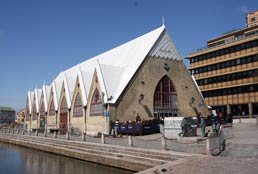 speaking staff in the TIC answered our questions with helpful
efficiency, adding to our stock of Swedish language for good measure. Following
the embankment of the Rosenlunds-kanalen, the former moat of the original
fortified city, we walked around past the buildings of Göteborg University where
city trams trundled to and fro across the bridge (Photo 11 - Göteborg tram crossing Rosenlunds-kanalen).
Nearby we came to Stora Saluhallen, a grand barrel-roofed structure dating from
the 1880s housing the city's wonderful indoor market (see left). Now regular
readers of our travels will know that ambling around markets is one of our
favourite pastimes, and Göteborg Saluhallen did not disappoint (Photo 12 - Göteborg's Stora Saluhallen market-hall).
This was a busy and wonderfully atmospheric market and we happily browsed the
butchery, vegetable and cheese stalls along with local shoppers; the
appetising food stalls were an obvious lunch venue for good value bowls of tasty speaking staff in the TIC answered our questions with helpful
efficiency, adding to our stock of Swedish language for good measure. Following
the embankment of the Rosenlunds-kanalen, the former moat of the original
fortified city, we walked around past the buildings of Göteborg University where
city trams trundled to and fro across the bridge (Photo 11 - Göteborg tram crossing Rosenlunds-kanalen).
Nearby we came to Stora Saluhallen, a grand barrel-roofed structure dating from
the 1880s housing the city's wonderful indoor market (see left). Now regular
readers of our travels will know that ambling around markets is one of our
favourite pastimes, and Göteborg Saluhallen did not disappoint (Photo 12 - Göteborg's Stora Saluhallen market-hall).
This was a busy and wonderfully atmospheric market and we happily browsed the
butchery, vegetable and cheese stalls along with local shoppers; the
appetising food stalls were an obvious lunch venue for good value bowls of tasty
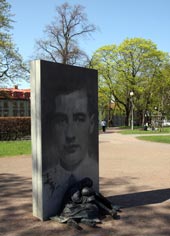 fish-soup. Göteborg's indoor 1874
fish-market, the Feskekörka, is an attractive curiosity resembling externally a
Neo-Gothic church (see right). The only worship here however is of fish, fish
and more fish, stalls laden with every kind of fish and shellfish; it was a
sight and smell to delight any fish-loving palate (Photo 13 - Feskekôrka indoor fish market). fish-soup. Göteborg's indoor 1874
fish-market, the Feskekörka, is an attractive curiosity resembling externally a
Neo-Gothic church (see right). The only worship here however is of fish, fish
and more fish, stalls laden with every kind of fish and shellfish; it was a
sight and smell to delight any fish-loving palate (Photo 13 - Feskekôrka indoor fish market).
 Passing
all the trendy and overpriced bars and restaurants along the wide boulevard of
Avenyn, we followed the regally named Vasa-gatan to a park by the church of
Hagakyrka and the memorial to Raoul Wallenberg, the Swedish businessman-diplomat
who rescued 1000s of Hungarian Jews from certain death at German hands in 1944
and who mysteriously disappeared after the 1945 Soviet 'liberation' of Budapest.
Youngsters lolled on the grass or played ball games, indifferent to the
distinctive monolith engraved with Wallenberg's portrait and small figures of
Jewish victims squatting forlornly at the base of the memorial (see left).
Returning through the parkland opposite the university where students picnicked
on the grass beside the canal, we walked up Västra Hamngatan to Göteborg Cathedral,
the Domkyrkan (see right). The original church was built soon after Gustav II Adolphus' foundation of the city and was dedicated in 1633 as the diocesan
cathedral of Western Sweden. The present church dating from 1827 is the third on
the site, the first 2 having been destroyed by fires; fronted at the west end
portico by 4 huge sandstone columns, the beige exterior brickwork is matched by
even more starkly plain Lutheran interior. The only concession to adornment is
the ornately gilded post-resurrection empty cross with Christ's grave clothes
scattered around. Passing
all the trendy and overpriced bars and restaurants along the wide boulevard of
Avenyn, we followed the regally named Vasa-gatan to a park by the church of
Hagakyrka and the memorial to Raoul Wallenberg, the Swedish businessman-diplomat
who rescued 1000s of Hungarian Jews from certain death at German hands in 1944
and who mysteriously disappeared after the 1945 Soviet 'liberation' of Budapest.
Youngsters lolled on the grass or played ball games, indifferent to the
distinctive monolith engraved with Wallenberg's portrait and small figures of
Jewish victims squatting forlornly at the base of the memorial (see left).
Returning through the parkland opposite the university where students picnicked
on the grass beside the canal, we walked up Västra Hamngatan to Göteborg Cathedral,
the Domkyrkan (see right). The original church was built soon after Gustav II Adolphus' foundation of the city and was dedicated in 1633 as the diocesan
cathedral of Western Sweden. The present church dating from 1827 is the third on
the site, the first 2 having been destroyed by fires; fronted at the west end
portico by 4 huge sandstone columns, the beige exterior brickwork is matched by
even more starkly plain Lutheran interior. The only concession to adornment is
the ornately gilded post-resurrection empty cross with Christ's grave clothes
scattered around.
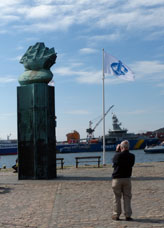 We continued north to Stenpiren (Stone Pier)
overlooking the wide Göta River with the city port's cranes lining the far bank.
Here on the quayside stands the Delaware Monument, a replica of the memorial set
up in America to the first Swedish emigrants who set off from here to find a new
life in 'New Sweden' on the banks of the Delaware River in 1638 (see left). Many 1000s of
Swedish emigrants followed fleeing the famines of the 19th century. Along the
embankment of Norra Hamngatan, we passed the Stadmuseum housed in what was once
the HQ and customs house of the Swedish East India Company whose affluence was
based on its monopolistic mercantile rights with the Far East on condition that
all its trading goods were auctioned here in Göteborg. The port-city also
prospered from this until competition from British and Dutch tea and spice
traders broke the monopoly. Just beyond we reached Gustav Adolfs We continued north to Stenpiren (Stone Pier)
overlooking the wide Göta River with the city port's cranes lining the far bank.
Here on the quayside stands the Delaware Monument, a replica of the memorial set
up in America to the first Swedish emigrants who set off from here to find a new
life in 'New Sweden' on the banks of the Delaware River in 1638 (see left). Many 1000s of
Swedish emigrants followed fleeing the famines of the 19th century. Along the
embankment of Norra Hamngatan, we passed the Stadmuseum housed in what was once
the HQ and customs house of the Swedish East India Company whose affluence was
based on its monopolistic mercantile rights with the Far East on condition that
all its trading goods were auctioned here in Göteborg. The port-city also
prospered from this until competition from British and Dutch tea and spice
traders broke the monopoly. Just beyond we reached Gustav Adolfs 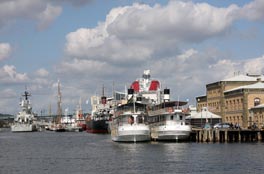 Torg, where
the city founder's grand statue stood in the centre of His Square; imperiously he
pointed to the spot where he wished his new city to be built - Right here, His
Majesty declared. Apparently the original statue commissioned from Germany was
kidnapped on its way to Sweden; rather than pay the ransom, the city merchant-venturers
simply ordered a new one, and here it stood in its eponymous square waiting to
be photographed (Photo 14 - Göteborg's founder King Gustav II Adolphus). Torg, where
the city founder's grand statue stood in the centre of His Square; imperiously he
pointed to the spot where he wished his new city to be built - Right here, His
Majesty declared. Apparently the original statue commissioned from Germany was
kidnapped on its way to Sweden; rather than pay the ransom, the city merchant-venturers
simply ordered a new one, and here it stood in its eponymous square waiting to
be photographed (Photo 14 - Göteborg's founder King Gustav II Adolphus).
On from here it was a short walk to the Lilla Bomman harbour,
now the city marina,
where the city's modernistic Opera House stood by the waterside. On the far side
a huge steel hulled sailing clipper was moored, over shadowed by the 86m high
lipstick-shaped tower block landmark of Utkiken (Photo 15 - Lilla Bommen Harbour and Utkiken tower).
Further round the harbour frontage, we reached the Maritime Museum's collection
of 20th century steamers, lightship, naval destroyer and tiny submarine the
Nordkapen all moored along the harbour-side, backed by the imposing building
of the port-city's Navigation School (see right). This is topped by its time-ball by which
ships' navigators set their chronometers. After such a fulfilling day in Göteborg,
we plodded back to the Nordstan Centre to catch our bus back out to the campsite
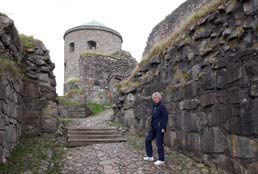 Kungälv
- Bohus Fästning medieval fortress, and a good campsite at last: we moved 12 kms north to the small town of Kungälv
where, on an island between the Rivers Göta and Nordre, Bohus Fästning
(Fortress) was built in 1308 by King Håkon V Magnusson of Norway to guard what
was then the southern border of his realm at its meeting point with the medieval
kingdoms of Sweden and Denmark. It was one of the mightiest castles in the Nordic lands, besieged 14 times but
never taken, and standing below its formidable walls, you could understand why.
Occupied by both the Norwegians and Danes during the first 350 years of its
existence Kungälv
- Bohus Fästning medieval fortress, and a good campsite at last: we moved 12 kms north to the small town of Kungälv
where, on an island between the Rivers Göta and Nordre, Bohus Fästning
(Fortress) was built in 1308 by King Håkon V Magnusson of Norway to guard what
was then the southern border of his realm at its meeting point with the medieval
kingdoms of Sweden and Denmark. It was one of the mightiest castles in the Nordic lands, besieged 14 times but
never taken, and standing below its formidable walls, you could understand why.
Occupied by both the Norwegians and Danes during the first 350 years of its
existence
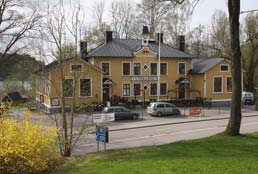 as
both a military stronghold and royal palace, it finally became Swedish under the
1658 Treaty of Roskilde. By the end of the 18th century with its military
significance past, troops were withdrawn and the castle abandoned; locals from Kungälv
plundered the ruins for building stone. Restoration began in the late 19th
century when the castle's historical worth was recognised. Its imposing remains
stand to this day and we spent the afternoon scrambling around the preserved
ruins of the fortress round tower and ramparts (see left) (Photo 16 - 14th century fortress at Kungälv).
Immediately opposite, we found tonight's base, the Kungälvs Vandrarhem (hostel)
and Camping (see right), a hospitable and straightforward little campsite in a
splendid riverbank setting overshadowed by Bohus castle. It had everything that
other campsites used so far had lacked: a peaceful setting free from noisy
holiday-makers, a lovely welcome, free wi-fi internet and very reasonable price,
a real little gem of a site. And we only discovered afterwards that Kungälv,
just 12 kms north of Göteborg, is also on a regular express bus route into the
city; we could have made our visit to Göteborg from here, staying at Kungälvs
Vandrarhem for almost half the price of the unsavoury Liseberg Askim Strand. as
both a military stronghold and royal palace, it finally became Swedish under the
1658 Treaty of Roskilde. By the end of the 18th century with its military
significance past, troops were withdrawn and the castle abandoned; locals from Kungälv
plundered the ruins for building stone. Restoration began in the late 19th
century when the castle's historical worth was recognised. Its imposing remains
stand to this day and we spent the afternoon scrambling around the preserved
ruins of the fortress round tower and ramparts (see left) (Photo 16 - 14th century fortress at Kungälv).
Immediately opposite, we found tonight's base, the Kungälvs Vandrarhem (hostel)
and Camping (see right), a hospitable and straightforward little campsite in a
splendid riverbank setting overshadowed by Bohus castle. It had everything that
other campsites used so far had lacked: a peaceful setting free from noisy
holiday-makers, a lovely welcome, free wi-fi internet and very reasonable price,
a real little gem of a site. And we only discovered afterwards that Kungälv,
just 12 kms north of Göteborg, is also on a regular express bus route into the
city; we could have made our visit to Göteborg from here, staying at Kungälvs
Vandrarhem for almost half the price of the unsavoury Liseberg Askim Strand.
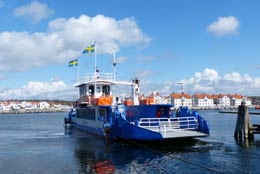 The Bohuslän
Coast - Marstrand: on
a rainy, blustery morning with a chill westerly wind blowing off the sea, we
drove out to the Bohuslän Coast, crossing causeways and an elegantly arched bridge
connecting a chain of islets ending at the island of Koön where the chain-ferry
connected to the car-free off-shore island of Marstrand. Marstrands Familje
Camping 1km inland from the ferry was totally deserted in early May, but the
owner responded to our phone call with the barrier key code; thankful to be away
from overcrowded holiday-camps, we relished another sensibly priced, welcoming
and peaceful campsite in a lovely rural setting and with free internet. A
peculiar Swedish dietary habit is their passion for meat balls (köttbullar), and
that evening as a warming antidote to the driving rain and cutting wind, we cooked our
first sample of köttbullar in tomato sauce with spaghetti, doubtless not the
Swedish way but it has now become our way! The following morning, we crossed by The Bohuslän
Coast - Marstrand: on
a rainy, blustery morning with a chill westerly wind blowing off the sea, we
drove out to the Bohuslän Coast, crossing causeways and an elegantly arched bridge
connecting a chain of islets ending at the island of Koön where the chain-ferry
connected to the car-free off-shore island of Marstrand. Marstrands Familje
Camping 1km inland from the ferry was totally deserted in early May, but the
owner responded to our phone call with the barrier key code; thankful to be away
from overcrowded holiday-camps, we relished another sensibly priced, welcoming
and peaceful campsite in a lovely rural setting and with free internet. A
peculiar Swedish dietary habit is their passion for meat balls (köttbullar), and
that evening as a warming antidote to the driving rain and cutting wind, we cooked our
first sample of köttbullar in tomato sauce with spaghetti, doubtless not the
Swedish way but it has now become our way! The following morning, we crossed by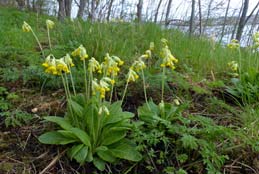 the little ferry which chugs back and forth across the narrow sound separating Marstrand from its neighbouring island, for the 6km walk around Marstrand's
shore-side footpath. The crossing takes just a couple of minutes, and in warm
clothes and full waterproofs against the chill wind, we set off along the
waterfront passing the little harbour's wooden houses which might have looked so
attractive in fine weather. But the Nordic gods were smiling on us today and by
the time we left the town behind and headed around the rocky coastline, the
cloud was starting to break. Being a safe and ice-free port, Marstrand had once
prospered from the herring-fishing
industry, but the herring disappeared taking with them the island's source of
prosperity. In the 19th century Marstrand's wooden fish-salting
the little ferry which chugs back and forth across the narrow sound separating Marstrand from its neighbouring island, for the 6km walk around Marstrand's
shore-side footpath. The crossing takes just a couple of minutes, and in warm
clothes and full waterproofs against the chill wind, we set off along the
waterfront passing the little harbour's wooden houses which might have looked so
attractive in fine weather. But the Nordic gods were smiling on us today and by
the time we left the town behind and headed around the rocky coastline, the
cloud was starting to break. Being a safe and ice-free port, Marstrand had once
prospered from the herring-fishing
industry, but the herring disappeared taking with them the island's source of
prosperity. In the 19th century Marstrand's wooden fish-salting
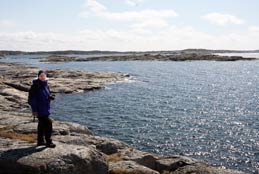 sheds were
converted into bathing houses and the little port re-invented itself as a fashionable
bathing resort. Today the port attracts the affluent yachting hoards in summer
but in early May the town was a quiet sleepy place with the harbour side
restaurants just beginning to prepare for summer influx of tourists. The
footpath sloped up past glorious banks of cowslips (see right) onto the cliff-tops
overlooking the sound with a side path branching down through a narrow squeeze
in high rocks, and we wound a slippery way among the rocks to the craggy
shore-line where eider ducks bobbed in the water with their characteristic 'oo-ing'
sound and terns flitted overhead making their piercing alarm calls. As we
rounded the island's western tip with its small lighthouse, the sun miraculously
broke through but with the SW wind still blowing briskly chill
(Photo 17 - Marstrand's rocky shoreline). We
followed the path over the shore-side rocks revelling in the glorious light
sparkling across the sea (see left), eventually completing the circuit back into the
southern end of Marstrand town by the sound to walk along the harbour front past
the wooden houses (Photo 18 - Wooden houses along Marstrand's waterfront).
We joined local people returning by the ferry across the sound, and walked back
to camp after such a glorious day's walk around Marstrand's rocky shore. sheds were
converted into bathing houses and the little port re-invented itself as a fashionable
bathing resort. Today the port attracts the affluent yachting hoards in summer
but in early May the town was a quiet sleepy place with the harbour side
restaurants just beginning to prepare for summer influx of tourists. The
footpath sloped up past glorious banks of cowslips (see right) onto the cliff-tops
overlooking the sound with a side path branching down through a narrow squeeze
in high rocks, and we wound a slippery way among the rocks to the craggy
shore-line where eider ducks bobbed in the water with their characteristic 'oo-ing'
sound and terns flitted overhead making their piercing alarm calls. As we
rounded the island's western tip with its small lighthouse, the sun miraculously
broke through but with the SW wind still blowing briskly chill
(Photo 17 - Marstrand's rocky shoreline). We
followed the path over the shore-side rocks revelling in the glorious light
sparkling across the sea (see left), eventually completing the circuit back into the
southern end of Marstrand town by the sound to walk along the harbour front past
the wooden houses (Photo 18 - Wooden houses along Marstrand's waterfront).
We joined local people returning by the ferry across the sound, and walked back
to camp after such a glorious day's walk around Marstrand's rocky shore.
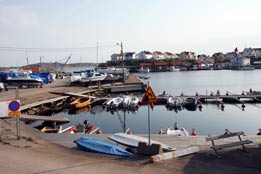 Island of Tjörn and Fishing village of
Klädesholmen: the following morning, we re-crossed the bridge and
causeways linking the islets of the archipelago, over the elegant bridge linking
to the larger Bohuslän island of Tjörn. Down at the island's SW tip we reached
the large fishing village of Klädesholmen spread across 2 interconnected
off-shore islets. Klädesholmen was also once a major herring fishing port with
30 fish-processing factories as described in the Herring Museum; but with the
disappearance of the herring, only a fraction of the former industry survives.
Former fishermen's cottages and sheds have now been converted to twee
residences, but the village is still a charming place. We spent a peacefully
contented afternoon wandering around the lanes and alleyways, with views between
white-painted cottages and red-painted former fishing sheds over small
anchorages out to the distant islands of the archipelago (Photo 19 - Fishing village of Klädesholmen on Tjörn island).
Across a small bridge connecting to Klädesholmen's outer islet, we continued
along Fiskhamnväg over a hillock down to the tiny harbour of Västra Hamn. Here
around the anchorage working fishing boats and smaller craft were moored (see
right). Not
only was this a peaceful and attractive setting among all the boats, looking
across the water to the white-painted cottages and church on the headland
opposite, of equal interest to us was the sheltered parking area by the
guest-harbour's toilets-showers: here was a perfect spot for tonight's camp. The
harbour-master was agreeable charging us 150kr as for the gästhamn, and we
settled in tucked behind a large rocky outcrop looking out over the boats in the
harbour and cottages across the bay; it was a truly beautiful spot to camp (Photo 20 - Camp at Klädesholmen's Västra Hamn fishing harbour). Island of Tjörn and Fishing village of
Klädesholmen: the following morning, we re-crossed the bridge and
causeways linking the islets of the archipelago, over the elegant bridge linking
to the larger Bohuslän island of Tjörn. Down at the island's SW tip we reached
the large fishing village of Klädesholmen spread across 2 interconnected
off-shore islets. Klädesholmen was also once a major herring fishing port with
30 fish-processing factories as described in the Herring Museum; but with the
disappearance of the herring, only a fraction of the former industry survives.
Former fishermen's cottages and sheds have now been converted to twee
residences, but the village is still a charming place. We spent a peacefully
contented afternoon wandering around the lanes and alleyways, with views between
white-painted cottages and red-painted former fishing sheds over small
anchorages out to the distant islands of the archipelago (Photo 19 - Fishing village of Klädesholmen on Tjörn island).
Across a small bridge connecting to Klädesholmen's outer islet, we continued
along Fiskhamnväg over a hillock down to the tiny harbour of Västra Hamn. Here
around the anchorage working fishing boats and smaller craft were moored (see
right). Not
only was this a peaceful and attractive setting among all the boats, looking
across the water to the white-painted cottages and church on the headland
opposite, of equal interest to us was the sheltered parking area by the
guest-harbour's toilets-showers: here was a perfect spot for tonight's camp. The
harbour-master was agreeable charging us 150kr as for the gästhamn, and we
settled in tucked behind a large rocky outcrop looking out over the boats in the
harbour and cottages across the bay; it was a truly beautiful spot to camp (Photo 20 - Camp at Klädesholmen's Västra Hamn fishing harbour).
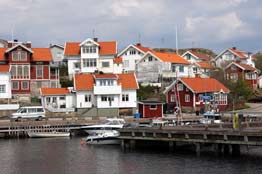 The Bohuslän islands of Orust and Malö, and fishing port of Mollösund:
moving north, we crossed a further bridge across the narrow sound separating Tjörn
from Sweden's 3rd largest island, Orust. The central part of Orust was
surprisingly wooded with spectacular rocky outcrops and cleared farmland in the
areas between. At the end of a long inlet at the SW tip of the island, we
reached the small fishing port of Mollösund, clearly not a place to visit in
summer when the tiny village and harbour would be overwhelmed with
tourists. In mid-May the delightful place was deserted and we were able to park
right by the harbour-side where a few boats were moored (see left). Again we spent a happy
afternoon ambling around the harbour and fishing-processing factories, and the
cobbled lanes between the cottages and anchorages (Photo 21 - harbour-village
of Mollösund on Orust).
How many of these, we wondered were occupied by working residents rather than
holiday homes for city dwellers from Göteborg? We were told of a small campsite
on the further island of Malö, and expecting to cross by another bridge, we were
surprised when the road descended to the intervening sound ending at a barrier
and red traffic light for a small car-ferry. The ferry waited for the bus on the
far shore and we crossed without charge to Malö. After a night's camp, we
crossed the tiny island of Malö with its stunningly beautiful terrain of rocky
outcrops, passing farmsteads and tiny inlets with boats moored, for the
car-ferry linking back to the long mainland peninsula that extends out
into the Bohuslän archipelago to Fiskebäckskils (Photo 22 - Car ferry from Malö back to Bokenäs peninsula). The Bohuslän islands of Orust and Malö, and fishing port of Mollösund:
moving north, we crossed a further bridge across the narrow sound separating Tjörn
from Sweden's 3rd largest island, Orust. The central part of Orust was
surprisingly wooded with spectacular rocky outcrops and cleared farmland in the
areas between. At the end of a long inlet at the SW tip of the island, we
reached the small fishing port of Mollösund, clearly not a place to visit in
summer when the tiny village and harbour would be overwhelmed with
tourists. In mid-May the delightful place was deserted and we were able to park
right by the harbour-side where a few boats were moored (see left). Again we spent a happy
afternoon ambling around the harbour and fishing-processing factories, and the
cobbled lanes between the cottages and anchorages (Photo 21 - harbour-village
of Mollösund on Orust).
How many of these, we wondered were occupied by working residents rather than
holiday homes for city dwellers from Göteborg? We were told of a small campsite
on the further island of Malö, and expecting to cross by another bridge, we were
surprised when the road descended to the intervening sound ending at a barrier
and red traffic light for a small car-ferry. The ferry waited for the bus on the
far shore and we crossed without charge to Malö. After a night's camp, we
crossed the tiny island of Malö with its stunningly beautiful terrain of rocky
outcrops, passing farmsteads and tiny inlets with boats moored, for the
car-ferry linking back to the long mainland peninsula that extends out
into the Bohuslän archipelago to Fiskebäckskils (Photo 22 - Car ferry from Malö back to Bokenäs peninsula).
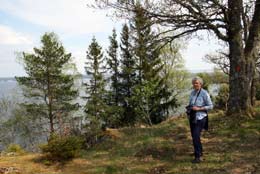 Back inland to Lake
Vänern and Halleberg-Hunneberg Plateau Nature
Reserve: the following morning's drive back inland would involve the
whole spectrum of roads, starting on the peaceful single-track rural lane across Malö,
minor roads, and finally the busy Route 44 motorway past Uddevalla to Vänersborg.
Our impression so far was that Swedish drivers were generally patient and
considerate, drove at speed when sensible but observed speed limits faithfully
without the aggressive overtaking, tail-gating and cutting in that now bedevils
driving in UK. Beyond Vänersborg, we crossed the wide River Göta which exits
from the inland-sea of Lake Vänern to flow as the Göta Canal down to Göteborg.
Leaving the main road, we took a winding minor road gaining height onto the
thickly wooded rocky Hunneberg Plateau. We knew of walks around the nature
reserve but needed a detailed map from the museum at the former royal hunting
lodge here. The elderly gent here charmed us with tales of Hunneberg's
history, culture and Back inland to Lake
Vänern and Halleberg-Hunneberg Plateau Nature
Reserve: the following morning's drive back inland would involve the
whole spectrum of roads, starting on the peaceful single-track rural lane across Malö,
minor roads, and finally the busy Route 44 motorway past Uddevalla to Vänersborg.
Our impression so far was that Swedish drivers were generally patient and
considerate, drove at speed when sensible but observed speed limits faithfully
without the aggressive overtaking, tail-gating and cutting in that now bedevils
driving in UK. Beyond Vänersborg, we crossed the wide River Göta which exits
from the inland-sea of Lake Vänern to flow as the Göta Canal down to Göteborg.
Leaving the main road, we took a winding minor road gaining height onto the
thickly wooded rocky Hunneberg Plateau. We knew of walks around the nature
reserve but needed a detailed map from the museum at the former royal hunting
lodge here. The elderly gent here charmed us with tales of Hunneberg's
history, culture and
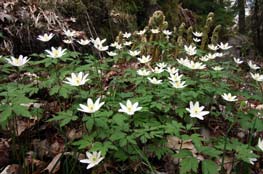 geology, when all we wanted was a map and details of walks.
We did however learn that the 2 plateaux of Hunneberg/Halleberg had originally
been one plug of hard erosion-resistant rock created by the intrusion of magma
into the softer surrounding bedrock which had over time eroded leaving the
resistant plateau exposed with its sheer craggy cliff-edges rising 50m above the
surrounding plain and Lake Vänern. The plateau had been cleaved by tectonic
movement leaving a valley separating the 2 now distinct plateaux. Armed with our
map, we followed a lane up onto the northern wooded plateau of Halleberg to its
northern end. A path led to the plateau's eastern cliff-edge looking out across
over the inland sea of Lake Vänern which faded into the misty distance to the NE
with no trace of land (Photo 23 - Inland sea of Lake Vänern from Halleberg plateau).
We followed the nature reserve circular way-marked path around the cliffs of the
plateau's northern tip through the original oak and spruce forest, but it was
the delightful woodland flora that made this walk so memorable, particularly the
carpets of wood anemones (see left), occasional hepatica, wood sorrel, bilberry with its
bright green new leaf and tiny pink globular flowers, and patches of
distinctive lingonberry leaves, covering the woodland floor. At the northern
tip, another lookout point above the plateau's lofty cliff edge gave views out
across Lake Vänern (see right). This was a truly magical woodland walk especially in bright
afternoon sunshine. geology, when all we wanted was a map and details of walks.
We did however learn that the 2 plateaux of Hunneberg/Halleberg had originally
been one plug of hard erosion-resistant rock created by the intrusion of magma
into the softer surrounding bedrock which had over time eroded leaving the
resistant plateau exposed with its sheer craggy cliff-edges rising 50m above the
surrounding plain and Lake Vänern. The plateau had been cleaved by tectonic
movement leaving a valley separating the 2 now distinct plateaux. Armed with our
map, we followed a lane up onto the northern wooded plateau of Halleberg to its
northern end. A path led to the plateau's eastern cliff-edge looking out across
over the inland sea of Lake Vänern which faded into the misty distance to the NE
with no trace of land (Photo 23 - Inland sea of Lake Vänern from Halleberg plateau).
We followed the nature reserve circular way-marked path around the cliffs of the
plateau's northern tip through the original oak and spruce forest, but it was
the delightful woodland flora that made this walk so memorable, particularly the
carpets of wood anemones (see left), occasional hepatica, wood sorrel, bilberry with its
bright green new leaf and tiny pink globular flowers, and patches of
distinctive lingonberry leaves, covering the woodland floor. At the northern
tip, another lookout point above the plateau's lofty cliff edge gave views out
across Lake Vänern (see right). This was a truly magical woodland walk especially in bright
afternoon sunshine.
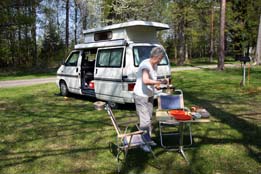 Trollhättan with its dam sluice-gate
waterfalls and excellent campsite: we joined the afternoon traffic on the
main road running alongside the Halleberg Plateau, with the 50m cliffs of its
western edge catching the afternoon sun, into the outskirts of Trollhättan, an
industrial town which developed on the banks of the Göta River/Canal. At the
town's campsite, we were welcomed with smilingly genuine hospitality; tired
after a long day, you could not have asked for a more kindly welcome: nothing
was too much trouble, showing an empathic understanding towards weary travellers
and giving us a street plan and directions for our visit to Trollhättan and the
best location for seeing the town's weekly spectacle, the opening of the sluice
gates on the Göta River dam which creates magnificent waterfalls. You are our
guests he said, a lesson which so many other campsite could usefully follow. For
a city campsite, 15 minutes' walk from the centre, the setting was delightfully
wooded, and the facilities spotlessly clean and modern. This really was a first
class and well-run campsite (see right). We later learnt that the Saab motor manufacturer
had had its main assembly plant here at Trollhättan but the firm had gone bust
and the plant, the town's largest employer had closed 2 years ago with the loss
of 4,000 jobs Trollhättan with its dam sluice-gate
waterfalls and excellent campsite: we joined the afternoon traffic on the
main road running alongside the Halleberg Plateau, with the 50m cliffs of its
western edge catching the afternoon sun, into the outskirts of Trollhättan, an
industrial town which developed on the banks of the Göta River/Canal. At the
town's campsite, we were welcomed with smilingly genuine hospitality; tired
after a long day, you could not have asked for a more kindly welcome: nothing
was too much trouble, showing an empathic understanding towards weary travellers
and giving us a street plan and directions for our visit to Trollhättan and the
best location for seeing the town's weekly spectacle, the opening of the sluice
gates on the Göta River dam which creates magnificent waterfalls. You are our
guests he said, a lesson which so many other campsite could usefully follow. For
a city campsite, 15 minutes' walk from the centre, the setting was delightfully
wooded, and the facilities spotlessly clean and modern. This really was a first
class and well-run campsite (see right). We later learnt that the Saab motor manufacturer
had had its main assembly plant here at Trollhättan but the firm had gone bust
and the plant, the town's largest employer had closed 2 years ago with the loss
of 4,000 jobs
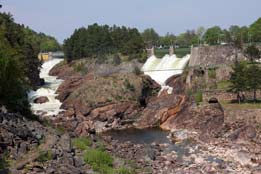 and 3,000 further jobs in associates industries. What a blow this
must have been for a small community. and 3,000 further jobs in associates industries. What a blow this
must have been for a small community.
The following day, we set off to walk from the
campsite along the river/canal-side footpath into the town. The Volvo Aerospace
company has a manufacturing centre at Trollhättan and the town is also home to
Sweden's film industry, known colloquially as 'Trollywood'. Trollhättan's main
street of Storgatan is paved with Hollywood style pavement plaques, the town's
hall of fame naming some of the international film stars who have figured in movies
made in Trollywood. But our objective
today was to learn something of its industrial heritage with the important
navigable Göta Canal with its locks and the HEP generating plants along the Göta
River gorge.
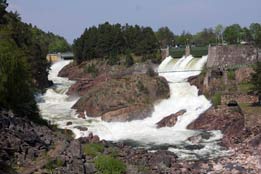 The
day's highlight was to be the opening of the HEP dam's sluice
gates creating 2 enormous waterfalls in the Göta gorge which during the
non-summer months only happens once a week at 3-00pm on Saturdays; our visit to Trollhättan
had been timed to coincide with this spectacle. The footpath ran through
parkland along an embankment separating the river's wide natural course from the
maintained canal still widely used by both commercial cargo shipping and pleasure
craft. At the centre of the town, the river's natural course and the modern,
artificially cut canal parted company. We continued ahead along the canal
embankment to reach an electrical distribution station close to one of the HEP
generating plants. Here we cut across the Oskarbron, a high lofty modern
bridge spanning the 150 feet deep craggy river gorge, now totally dry with the
river dammed for the nearby Hojums HEP generating plant. The
day's highlight was to be the opening of the HEP dam's sluice
gates creating 2 enormous waterfalls in the Göta gorge which during the
non-summer months only happens once a week at 3-00pm on Saturdays; our visit to Trollhättan
had been timed to coincide with this spectacle. The footpath ran through
parkland along an embankment separating the river's wide natural course from the
maintained canal still widely used by both commercial cargo shipping and pleasure
craft. At the centre of the town, the river's natural course and the modern,
artificially cut canal parted company. We continued ahead along the canal
embankment to reach an electrical distribution station close to one of the HEP
generating plants. Here we cut across the Oskarbron, a high lofty modern
bridge spanning the 150 feet deep craggy river gorge, now totally dry with the
river dammed for the nearby Hojums HEP generating plant.
 From here, although we
could not see the lake retained by the 2 dams to create the head of water to
drive the generating plants turbines, we did have a perfect view 800m upstream
of the dam's sluice gates which would be opened to create the waterfalls spectacle filling the now dry gorge 150 feet below us. At 3-00pm a sudden
cascade of white water surged from the left-hand sluice gates snaking with
remarkable tardiness down into the rocky gorge and swelling out into a foaming
torrent. Equally suddenly, a similar torrent gushed from the other sluice
surging slowly down into the gorge bed to merge with the first to form one mass
of water advancing down into the dry bed. All of this seemed to happen in slow
motion taking a full 4 minutes from when the 2 sluices were opened to when the
merged nose of white water passed down the gorge's dry bed under the bridge
below us (Photos 24 & 25 - Start of Trollhättan waterfalls and merged torrent in full spate).
We stood in astonishment on the bridge gazing down at this remarkable spectacle. From here, although we
could not see the lake retained by the 2 dams to create the head of water to
drive the generating plants turbines, we did have a perfect view 800m upstream
of the dam's sluice gates which would be opened to create the waterfalls spectacle filling the now dry gorge 150 feet below us. At 3-00pm a sudden
cascade of white water surged from the left-hand sluice gates snaking with
remarkable tardiness down into the rocky gorge and swelling out into a foaming
torrent. Equally suddenly, a similar torrent gushed from the other sluice
surging slowly down into the gorge bed to merge with the first to form one mass
of water advancing down into the dry bed. All of this seemed to happen in slow
motion taking a full 4 minutes from when the 2 sluices were opened to when the
merged nose of white water passed down the gorge's dry bed under the bridge
below us (Photos 24 & 25 - Start of Trollhättan waterfalls and merged torrent in full spate).
We stood in astonishment on the bridge gazing down at this remarkable spectacle.
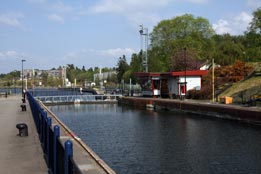 But
that was not the end of our appreciation of the industrial exploitation of the Göta
River; there was now the remarkable story of the Canal's development and the
problems facing its designers in engineering a navigable passage to bypass this
formidable obstacle of the Göta's 150 feet deep gorge. Earlier attempts to
achieve this had been foiled by technological inadequacies. But in 1844, enter
one Nils Ericson (1802~70), civil engineer extraordinary and Sweden's equivalent
of I K Brunel. He had been responsible for construction of the Saimaa Canal in
what was then Swedish Finland which we had travelled on last year to the now
Russian port of Vyborg. In order to bypass the Göta River's insurmountable
natural course, Ericson had to blast out an entirely new channel from the bed
rock parallel with but some distance from the river's natural course; there was
then the problem of lowering the new cut down the 150 feet drop in order for boats to
rejoin the river downstream of the gorge. Ericson achieved this with a long
series of locks (slussar) which we now walked to see (see right). The current
navigable channel was impressively wide and the on-going series of locks
continued for some distance from the top lock towards the lower river. A walk
back on the footpath alongside Ericson's canal cut further impressed us with the
creativity of this remarkable engineer who went on to develop the entire Swedish
national railway system. Before leaving we walked around to the lake retained
behind the dam; the footbridge spanning the dam gave a breath-taking impression
of the height loss in the river's gorge which Ericson's canal had to drop by
means of the flight of locks. We plodded wearily back to camp after such an
inspiring day of discovery, understanding more about Trollhättan's remarkable
industrial heritage and the twin exploitation of the Göta River both for canal
navigation and HEP generation. It is always the sign of a good campsite when you
are sorry to be leaving, and we had enjoyed an excellent stay here at
Trollhättan Camping. But
that was not the end of our appreciation of the industrial exploitation of the Göta
River; there was now the remarkable story of the Canal's development and the
problems facing its designers in engineering a navigable passage to bypass this
formidable obstacle of the Göta's 150 feet deep gorge. Earlier attempts to
achieve this had been foiled by technological inadequacies. But in 1844, enter
one Nils Ericson (1802~70), civil engineer extraordinary and Sweden's equivalent
of I K Brunel. He had been responsible for construction of the Saimaa Canal in
what was then Swedish Finland which we had travelled on last year to the now
Russian port of Vyborg. In order to bypass the Göta River's insurmountable
natural course, Ericson had to blast out an entirely new channel from the bed
rock parallel with but some distance from the river's natural course; there was
then the problem of lowering the new cut down the 150 feet drop in order for boats to
rejoin the river downstream of the gorge. Ericson achieved this with a long
series of locks (slussar) which we now walked to see (see right). The current
navigable channel was impressively wide and the on-going series of locks
continued for some distance from the top lock towards the lower river. A walk
back on the footpath alongside Ericson's canal cut further impressed us with the
creativity of this remarkable engineer who went on to develop the entire Swedish
national railway system. Before leaving we walked around to the lake retained
behind the dam; the footbridge spanning the dam gave a breath-taking impression
of the height loss in the river's gorge which Ericson's canal had to drop by
means of the flight of locks. We plodded wearily back to camp after such an
inspiring day of discovery, understanding more about Trollhättan's remarkable
industrial heritage and the twin exploitation of the Göta River both for canal
navigation and HEP generation. It is always the sign of a good campsite when you
are sorry to be leaving, and we had enjoyed an excellent stay here at
Trollhättan Camping.
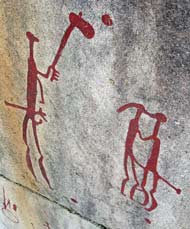 North towards the Norwegian border and the
Tanum-Vitlycke Bronze Age rock engravings: the E6 motorway northwards
passing through increasingly spectacular terrain of wooded hills, with
occasional glimpses of coastal fjords and sensational viaducts spanning broad
valleys. We turned off North towards the Norwegian border and the
Tanum-Vitlycke Bronze Age rock engravings: the E6 motorway northwards
passing through increasingly spectacular terrain of wooded hills, with
occasional glimpses of coastal fjords and sensational viaducts spanning broad
valleys. We turned off
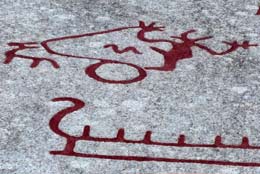 onto
a minor road leading to the Tanum-Vitlycke Museum which we hoped would provide interpretation of the prehistoric rock engravings around Tanum
to supplement the Rock Carvings Tour booklet bought at the North Bohusläs
Museum in Uddevalla. The
panels of rock art around North Bohuslän dating from the mid-late Bronze Age
around 1500~500 BC were chiselled onto flat panels of bed-rock granite using
flint tools. At that time, sea levels were higher than today so that most of the
panels were along fjord shore-lines. Unlike the Neolithic nomadic hunter-gathers
who had created the ritual engravings at Alta in North Norway seen by us last
year, the Tanum rock art was created by a more settled agricultural culture who
supplemented their pastoral existence keeping sheep, pigs and cattle and working
the land to grow barley and rye, with hunting in the surrounding forests. Bronze
was bartered from Europe for skins and local produce, and smelted for weapons
and ceremonial ornaments. The carved rock figures supported by archaeological
finds show a continuity of occupation and land use for over 1000 years. There
are 4 areas of rock engravings, and the panel at Tanum-Vitlycke was clearly
visible on the opposite hillside. As at Alta, the figures engraved on the flat
granite panels had controversially been coloured in with red paint to make them
more visible to modern day visitors (Photo 26 - Tanum Bronze Age rock engravings from 1500~500 BC).
Although difficult to interpret, the art-work of some 300 human and animal
figures, boats and other symbols is thought to represent religious ceremonial
ritual, fertility rites and representation of the passage from life to death.
The
best-known figures are a male-female pairing known as 'The Lovers' engaged
in an obvious human act but with a warrior figure holding an axe above the onto
a minor road leading to the Tanum-Vitlycke Museum which we hoped would provide interpretation of the prehistoric rock engravings around Tanum
to supplement the Rock Carvings Tour booklet bought at the North Bohusläs
Museum in Uddevalla. The
panels of rock art around North Bohuslän dating from the mid-late Bronze Age
around 1500~500 BC were chiselled onto flat panels of bed-rock granite using
flint tools. At that time, sea levels were higher than today so that most of the
panels were along fjord shore-lines. Unlike the Neolithic nomadic hunter-gathers
who had created the ritual engravings at Alta in North Norway seen by us last
year, the Tanum rock art was created by a more settled agricultural culture who
supplemented their pastoral existence keeping sheep, pigs and cattle and working
the land to grow barley and rye, with hunting in the surrounding forests. Bronze
was bartered from Europe for skins and local produce, and smelted for weapons
and ceremonial ornaments. The carved rock figures supported by archaeological
finds show a continuity of occupation and land use for over 1000 years. There
are 4 areas of rock engravings, and the panel at Tanum-Vitlycke was clearly
visible on the opposite hillside. As at Alta, the figures engraved on the flat
granite panels had controversially been coloured in with red paint to make them
more visible to modern day visitors (Photo 26 - Tanum Bronze Age rock engravings from 1500~500 BC).
Although difficult to interpret, the art-work of some 300 human and animal
figures, boats and other symbols is thought to represent religious ceremonial
ritual, fertility rites and representation of the passage from life to death.
The
best-known figures are a male-female pairing known as 'The Lovers' engaged
in an obvious human act but with a warrior figure holding an axe above the
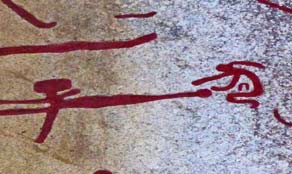 bonding couple's heads (see right). Another
figure portrayed a warrior wearing a horned helmet and travelling in a 2-wheeled
horse-drawn chariot;
the
nearby snake-like emblem is thought to represent a
lightning bolt and the charioteer perhaps an pre-cursor bonding couple's heads (see right). Another
figure portrayed a warrior wearing a horned helmet and travelling in a 2-wheeled
horse-drawn chariot;
the
nearby snake-like emblem is thought to represent a
lightning bolt and the charioteer perhaps an pre-cursor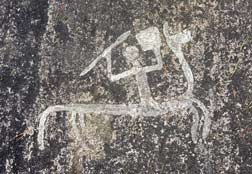 of the Nordic god of
thunder Thor (see left). There were also a number of boat figures thought
ritually to represent the passage from this life to the kingdom of the dead. In the centre of the panel was a unique depiction of a female figure
(distinguishable by her plaited hair) mourning a dead male (see left)
of the Nordic god of
thunder Thor (see left). There were also a number of boat figures thought
ritually to represent the passage from this life to the kingdom of the dead. In the centre of the panel was a unique depiction of a female figure
(distinguishable by her plaited hair) mourning a dead male (see left)
We drove around to the other 3 sites in the nearby
pine woods to examine more of the engravings. One panel showed a huge 2.3m high figure of a god
brandishing his spear. Some of the engravings had been spared the colouring to
reveal their original state, one of which dating from the early Iron Age showed
horsemen bearing spear and shield (see right). Others showed processions of
dancing figures and bulls with superimposed figure reminiscent of the Minoan
Cretan bull-leapers at Knossos (see left below); was this a common Bronze Age Indo-European
ritual theme? There were regular depictions of hunting scenes with warriors
pursuing animals with spears and bows (Photo 27 - Ritual hunting scene) and
axe-men with hunting dogs. We spent the whole afternoon photographing these
mysterious yet intensely human pieces of prehistoric artwork. We had envisaged
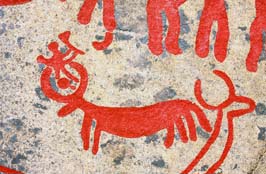 staying
that night at the small Tanums Camping, but found it closed. The only
alternative was one of the over-crowded and uninviting holiday-camps down at the
coast, the least unappealing of which, Saltviks Camping, enjoys the
distinction of being one of the most memorably disgusting campsites we have ever
had the misfortune to use, as well as over-pricey; the inhospitable
owner could not even be bothered to open the office, nor did we feel inclined to
part with kroner for such an unpleasant stay, and the following morning
thankfully hastened away to continue our journey northward. staying
that night at the small Tanums Camping, but found it closed. The only
alternative was one of the over-crowded and uninviting holiday-camps down at the
coast, the least unappealing of which, Saltviks Camping, enjoys the
distinction of being one of the most memorably disgusting campsites we have ever
had the misfortune to use, as well as over-pricey; the inhospitable
owner could not even be bothered to open the office, nor did we feel inclined to
part with kroner for such an unpleasant stay, and the following morning
thankfully hastened away to continue our journey northward.
The Blomsholm 'Stone Ship' Iron Age burial mound: as we drew closer to the
Norwegian border, upgrading of the road which led eventually to Oslo meant a
diversion with traffic queuing to rejoin the motorway; driving standards of the
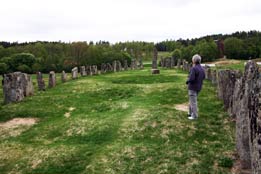 predominantly Norwegian traffic was far more aggressive and less tolerant than
Swedish drivers. Thankful to be leaving the motorway, we turned off on a quiet
lane to Blomholmens Säteris (manor house), the estate where the Blomsholm
Stenskeppet (Stone Ship) Iron Age burial mound is located. As we approached, the
standing stones forming the sip's outline could be seen topping a low hillock
across the fields. 49 standing stones arranged in the shape of a long boat, 41m
long and 9m wide with bow and stern stones 3m high (Photo 28 - Strömstad 'Stone Ship' Iron Age burial mound). Although it is the largest
such boat-grave in Sweden, little is known of its history. It is thought to date
from the late Iron Age, between 500~1000 AD, when sea levels were higher than
now and the lower ground near the grave would have been the shore-line of an
inlet from the sea. Boats clearly were of ritual importance to prehistoric
northern peoples as the rock art had shown, symbolising the passage from life to
death. Although the hillock forming tumulus beneath the stone-circle has never
been excavated, it is assumed that it marks a grave and the size of the monument
indicates an important chieftain. We had seen such smaller stone-ships in
Northern Jutland which once would have been buried under soil; this one however
was never covered and was designed to be visible from the shallow bay it
overlooked. Clearly this was an impressive monument even 1,500 years after it
received its VIP burial. predominantly Norwegian traffic was far more aggressive and less tolerant than
Swedish drivers. Thankful to be leaving the motorway, we turned off on a quiet
lane to Blomholmens Säteris (manor house), the estate where the Blomsholm
Stenskeppet (Stone Ship) Iron Age burial mound is located. As we approached, the
standing stones forming the sip's outline could be seen topping a low hillock
across the fields. 49 standing stones arranged in the shape of a long boat, 41m
long and 9m wide with bow and stern stones 3m high (Photo 28 - Strömstad 'Stone Ship' Iron Age burial mound). Although it is the largest
such boat-grave in Sweden, little is known of its history. It is thought to date
from the late Iron Age, between 500~1000 AD, when sea levels were higher than
now and the lower ground near the grave would have been the shore-line of an
inlet from the sea. Boats clearly were of ritual importance to prehistoric
northern peoples as the rock art had shown, symbolising the passage from life to
death. Although the hillock forming tumulus beneath the stone-circle has never
been excavated, it is assumed that it marks a grave and the size of the monument
indicates an important chieftain. We had seen such smaller stone-ships in
Northern Jutland which once would have been buried under soil; this one however
was never covered and was designed to be visible from the shallow bay it
overlooked. Clearly this was an impressive monument even 1,500 years after it
received its VIP burial.
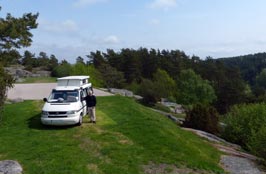 Strömstad Camping: we returned along the lane to negotiate the traffic queue
at the motorway junction, and on the outskirts of Strömstad pulled in at what we
thought was a shopping centre. But the predominance of Norwegian cars should
have alerted us that this was no conventional out-of-town supermarket. This was
hyper-greed at its very worst - cross-border trade where Norwegians swarmed
frantically in
their 1000s for cheap booze and consumer goods. Extricating ourselves from this
materialistic madness into Strömstad, we managed to park in the main street to
do our shopping at perfectly normal Co-op. Strömstad was a pleasant town: what had once been
a small fishing port had developed into a late 19th century spa town with the
main spa centre still dominating the marina. Ferries ran from here to the
off-shore Kosterhavet Islands, since 2009 protected as Sweden's first marine
national park. We were greeted at the local campsite with smiling hospitality
and a good value price of 210kr with no hidden extras and free wi-fi internet;
it was one of those campsites that recognises the sensible formula for success
of welcoming its guests as a hotel would. But the impressively distinctive
feature was the ingenious way it had managed somehow to implant flat and
extensive camping areas across the huge rocky outcrops of the broad headland on
which it was sited. We tucked ourselves into a secluded and sheltered corner
under a rocky outcrop overlooking the steep-sided valley of a fjord-inlet. This
was a magnificently unique spot in which to enjoy a day in camp (Photo 29 - Strömstad Camping on headland overlooking fjord-inlet). Strömstad Camping: we returned along the lane to negotiate the traffic queue
at the motorway junction, and on the outskirts of Strömstad pulled in at what we
thought was a shopping centre. But the predominance of Norwegian cars should
have alerted us that this was no conventional out-of-town supermarket. This was
hyper-greed at its very worst - cross-border trade where Norwegians swarmed
frantically in
their 1000s for cheap booze and consumer goods. Extricating ourselves from this
materialistic madness into Strömstad, we managed to park in the main street to
do our shopping at perfectly normal Co-op. Strömstad was a pleasant town: what had once been
a small fishing port had developed into a late 19th century spa town with the
main spa centre still dominating the marina. Ferries ran from here to the
off-shore Kosterhavet Islands, since 2009 protected as Sweden's first marine
national park. We were greeted at the local campsite with smiling hospitality
and a good value price of 210kr with no hidden extras and free wi-fi internet;
it was one of those campsites that recognises the sensible formula for success
of welcoming its guests as a hotel would. But the impressively distinctive
feature was the ingenious way it had managed somehow to implant flat and
extensive camping areas across the huge rocky outcrops of the broad headland on
which it was sited. We tucked ourselves into a secluded and sheltered corner
under a rocky outcrop overlooking the steep-sided valley of a fjord-inlet. This
was a magnificently unique spot in which to enjoy a day in camp (Photo 29 - Strömstad Camping on headland overlooking fjord-inlet).
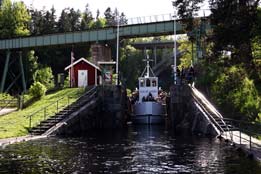 Inland to Dalsland and the Håverud Aqueduct: glad to be getting
away from rowdy Norwegians in their ludicrous mega-buses (this was not camping
but sordid materialism-on-wheels), today we should finally leave the Bohuslän
Coast and turn inland through a corner of southern Norway on minor roads through
forested and increasingly hilly terrain, to return inland to Dalsland and the
north shore of Lake Vänern. Re-crossing into Sweden onto Route 166, the terrain
was reminiscent of Finland with dense spruce and birch forests, much timber
cutting and the roads busy with timber trucks. The guest-harbour municipal
campsite provided a delightful base for our stay at Håverud on the shore of Lake
Övre Upperudshöljen, the first of a long series of linked linear lakes forming
the Dalsland Canal. The campsite was just 5 minutes' walk from the lower canal
basin, though at this stage we were still bewildered by the canal's upward
progress through its flight of 4 locks and aqueduct at Håverud, and the problems
caused by this peculiar topography for the canal builders in bypassing the
sheer-sided gorge and river-rapids down the 10m height difference between the
upper and lower lakes. Our time at Håverud was to teach us much. On the
afternoon of our arrival, we got our first impressions of the scale of this
engineering wonder as walked up the towpath past the flight of locks, under the
narrow metal railway bridge which spans the gorge overhead (see right), and across the
walkway of the riveted steel trough aqueduct, to watch a tourist boat returning
across the aqueduct and down through the locks. That evening in camp, we tried
to piece together our understanding of what we had seen of the aqueduct, but
there were still so many unanswered questions about the building of the canal
and the cargoes transported. Inland to Dalsland and the Håverud Aqueduct: glad to be getting
away from rowdy Norwegians in their ludicrous mega-buses (this was not camping
but sordid materialism-on-wheels), today we should finally leave the Bohuslän
Coast and turn inland through a corner of southern Norway on minor roads through
forested and increasingly hilly terrain, to return inland to Dalsland and the
north shore of Lake Vänern. Re-crossing into Sweden onto Route 166, the terrain
was reminiscent of Finland with dense spruce and birch forests, much timber
cutting and the roads busy with timber trucks. The guest-harbour municipal
campsite provided a delightful base for our stay at Håverud on the shore of Lake
Övre Upperudshöljen, the first of a long series of linked linear lakes forming
the Dalsland Canal. The campsite was just 5 minutes' walk from the lower canal
basin, though at this stage we were still bewildered by the canal's upward
progress through its flight of 4 locks and aqueduct at Håverud, and the problems
caused by this peculiar topography for the canal builders in bypassing the
sheer-sided gorge and river-rapids down the 10m height difference between the
upper and lower lakes. Our time at Håverud was to teach us much. On the
afternoon of our arrival, we got our first impressions of the scale of this
engineering wonder as walked up the towpath past the flight of locks, under the
narrow metal railway bridge which spans the gorge overhead (see right), and across the
walkway of the riveted steel trough aqueduct, to watch a tourist boat returning
across the aqueduct and down through the locks. That evening in camp, we tried
to piece together our understanding of what we had seen of the aqueduct, but
there were still so many unanswered questions about the building of the canal
and the cargoes transported.
 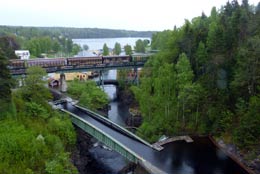 A visit to the Canal Museum down by the canal basin answered many of our
questions about the canal's history, its construction, the cargoes it carried,
the employment it brought, and its impact on the lives of those living along its
length. Iron ore mining and smelting had developed on an increasing scale during
the 17~early 19th centuries along the lakes of the remote regions of Dalsland
and Värmland, with pig iron transported by boat where rivers were navigable or
by carts along bumpy tracks. The Swedish parliament had eventually voted to fund
construction of a canal linking the elongated series of lakes to create a 250km
long waterway system between Töcksfors and the roadless wastes of Dalsland and
Lake Vänern. This was not a complex task since nature had done most of the work:
it required just 12 kms of canal cutting to connect the lakes and 31 locks to
overcome the 66m height difference between Lakes Stora Le and Vänern, to provide
a main commercial route for both raw materials and finished products for the
developing industry along the canal and daily needs of the growing population.
But the sting in the tail was at Håverud: here the 500m long river connecting
Lakes Åkläng and Övre Upperudshöljen dropped 10m down impassable rapids in a
sheer-side 500m narrow, precipitous gorge. Normal locks could not be constructed
on the loose rock in such ground conditions. The obstacle seemed insurmountable,
and lesser engineers considered alternative solutions. But again enter Nils
Ericson who was given responsibility for the project of overcoming the obstacle
at Håverud. Ericson, a remarkable engineer, much respected for his other
achievements including the work to bypass the gorge at Trollhättan, conceived a
brilliantly far-sighted and audacious solution. The problem at Håverud in the
confined, sheer-sided gorge was more complex than at Trollhättan: despite the
narrow gorge, Ericson however managed to squeeze his new cut alongside the river
falls with an artificial 'shelf' chopped into the gorge side-face on the inner A visit to the Canal Museum down by the canal basin answered many of our
questions about the canal's history, its construction, the cargoes it carried,
the employment it brought, and its impact on the lives of those living along its
length. Iron ore mining and smelting had developed on an increasing scale during
the 17~early 19th centuries along the lakes of the remote regions of Dalsland
and Värmland, with pig iron transported by boat where rivers were navigable or
by carts along bumpy tracks. The Swedish parliament had eventually voted to fund
construction of a canal linking the elongated series of lakes to create a 250km
long waterway system between Töcksfors and the roadless wastes of Dalsland and
Lake Vänern. This was not a complex task since nature had done most of the work:
it required just 12 kms of canal cutting to connect the lakes and 31 locks to
overcome the 66m height difference between Lakes Stora Le and Vänern, to provide
a main commercial route for both raw materials and finished products for the
developing industry along the canal and daily needs of the growing population.
But the sting in the tail was at Håverud: here the 500m long river connecting
Lakes Åkläng and Övre Upperudshöljen dropped 10m down impassable rapids in a
sheer-side 500m narrow, precipitous gorge. Normal locks could not be constructed
on the loose rock in such ground conditions. The obstacle seemed insurmountable,
and lesser engineers considered alternative solutions. But again enter Nils
Ericson who was given responsibility for the project of overcoming the obstacle
at Håverud. Ericson, a remarkable engineer, much respected for his other
achievements including the work to bypass the gorge at Trollhättan, conceived a
brilliantly far-sighted and audacious solution. The problem at Håverud in the
confined, sheer-sided gorge was more complex than at Trollhättan: despite the
narrow gorge, Ericson however managed to squeeze his new cut alongside the river
falls with an artificial 'shelf' chopped into the gorge side-face on the inner
 side and buttressed by outer side by an man-made wall above the falls. But his
pièce do résistance was to span the gorge itself with a 32.5m long steel trough
aqueduct to link the 2 sections of his new cut along which conventional locks
could manage the 10m height drop between the upper and lower lakes. This
brilliant design concept won approval. Sections of the steel trough were
fabricated in Stockholm and assembled on site to be slid into position bridging
the gorge in the most confined space above the rapids. The sections were joined
by some 33,000 rivets, and such was the craftsmanship that not one has needed
replacement. Construction of the Dalsland Canal lasted 4 years 1868 and it was
officially opened on 19 September 1868 by King Carl XV. Despite the brilliance
of Ericson's solution for overcoming the Håverud obstacle, the Dalsland Canal
was short-lived as a commercial trade route. Within decades Sweden's late-built
railways caught up fast, and the line through Dalsland, ironically passing over
Ericson's aqueduct on the steel trestle bridge (see right), quickly took over the transport
of goods and materials, leaving the canal to pleasure boats and holiday craft. side and buttressed by outer side by an man-made wall above the falls. But his
pièce do résistance was to span the gorge itself with a 32.5m long steel trough
aqueduct to link the 2 sections of his new cut along which conventional locks
could manage the 10m height drop between the upper and lower lakes. This
brilliant design concept won approval. Sections of the steel trough were
fabricated in Stockholm and assembled on site to be slid into position bridging
the gorge in the most confined space above the rapids. The sections were joined
by some 33,000 rivets, and such was the craftsmanship that not one has needed
replacement. Construction of the Dalsland Canal lasted 4 years 1868 and it was
officially opened on 19 September 1868 by King Carl XV. Despite the brilliance
of Ericson's solution for overcoming the Håverud obstacle, the Dalsland Canal
was short-lived as a commercial trade route. Within decades Sweden's late-built
railways caught up fast, and the line through Dalsland, ironically passing over
Ericson's aqueduct on the steel trestle bridge (see right), quickly took over the transport
of goods and materials, leaving the canal to pleasure boats and holiday craft.
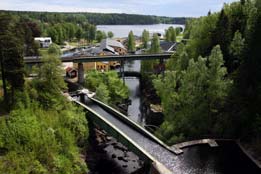 The following morning, from the modern road bridge high above
the village, we had a perfect aerial panorama of the entire setting of the
river's natural course down the gorge, the canal with its 4 locks overcoming the
height difference, the railway bridge passing over the whole ensemble, and of
course Ericson's aqueduct elegantly centre stage spanning the gorge (Photo 30 - Håverud Aqueduct carrying the Dalsland Canal over the river gorge).
The natural and man-made marvels were spread out below us, and from this vantage
point we watched the pleasure boat work its way up through the locks and slowly
advance across the aqueduct (see right) (Photo 31 - Boat crossing the Håverud Aqueduct).
From the other side of the bridge, we had a similar aerial view of the boat
passing along Ericson's shelf cut, out through the upper lock and out into Lake Åkläng
and pick up speed into the misty distance. We followed a foot path down under
the The following morning, from the modern road bridge high above
the village, we had a perfect aerial panorama of the entire setting of the
river's natural course down the gorge, the canal with its 4 locks overcoming the
height difference, the railway bridge passing over the whole ensemble, and of
course Ericson's aqueduct elegantly centre stage spanning the gorge (Photo 30 - Håverud Aqueduct carrying the Dalsland Canal over the river gorge).
The natural and man-made marvels were spread out below us, and from this vantage
point we watched the pleasure boat work its way up through the locks and slowly
advance across the aqueduct (see right) (Photo 31 - Boat crossing the Håverud Aqueduct).
From the other side of the bridge, we had a similar aerial view of the boat
passing along Ericson's shelf cut, out through the upper lock and out into Lake Åkläng
and pick up speed into the misty distance. We followed a foot path down under
the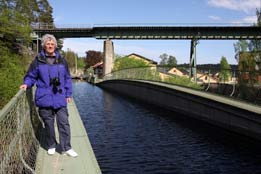 railway bridge to reach the tow path and crossed the narrow metal walkway above
the 2m deep trough of the aqueduct (see right) (Photo 32 - Walkway across Håverud Aqueduct).
Standing here so matter of factly, the brilliance of the aqueduct's visionary
conception and the skill of its construction might so easily be taken for
granted. From this position, we had a closer appreciation of the sturdily
buttressed artificially-constructed wall which contained the outer side of
Ericson's wide shelf to contain the canal's on-going passage on the far side of
the aqueduct (see left). We continued ahead above the river's rocky natural
gorge to the sluice gates through which water cascaded to control water levels
according to traffic through the canal locks. Crossing the canal on the
lock-gates enabled us to examine how the shelf had been cut out of the gorge's
sheer rock face, where drill marks from the original blasting showed the scale
of construction required. A memorial plaque on the rock wall commemorated Nils
Ericson as designer and his son Werner who had superintended construction.
railway bridge to reach the tow path and crossed the narrow metal walkway above
the 2m deep trough of the aqueduct (see right) (Photo 32 - Walkway across Håverud Aqueduct).
Standing here so matter of factly, the brilliance of the aqueduct's visionary
conception and the skill of its construction might so easily be taken for
granted. From this position, we had a closer appreciation of the sturdily
buttressed artificially-constructed wall which contained the outer side of
Ericson's wide shelf to contain the canal's on-going passage on the far side of
the aqueduct (see left). We continued ahead above the river's rocky natural
gorge to the sluice gates through which water cascaded to control water levels
according to traffic through the canal locks. Crossing the canal on the
lock-gates enabled us to examine how the shelf had been cut out of the gorge's
sheer rock face, where drill marks from the original blasting showed the scale
of construction required. A memorial plaque on the rock wall commemorated Nils
Ericson as designer and his son Werner who had superintended construction.
Our time at Håverud and all that we had learnt about the Håverud Aqueduct,
filled us with further admiration at Ericson's ingenuity as a designer and of
19th century engineering craftsmanship.
Högsbyn Nature Reserve and rock engravings:
following the single-track, winding lane from Håverud through sunlit birch
woodland, we drove the 10km to find Högsbyn Nature Reserve. This was to be an
afternoon of delights for us both: a 3km circular walk passing Bronze Age rock
engravings and wild flora galore in beautiful lakeside meadows and woodland. The
Högsbyn rock engravings (hällristnings) dated from the late Bronze Age around
1500~500 BC and were created by settled pasturalists on small exposed panels of
bedrock and completely open to view by the lakeside (Photo 33 - Högsbyn Bronze Age rock engravings by Lake Råvarpen). But whereas the rock art at Tanum was generally pictorial in style with human figures performing various
cult acts, ships and animals, those at Högsbyn, again coloured in with red paint
to aid visibility, were much more symbolic in form with fewer human figures and
far more difficult to interpret or understand. The most evident panel portrayed
a cult ship with an acrobat figure turning a back-somersault above the boat
again much like the Minoan bull-leapers (Photo 34 - Detail of Högsbyn Bronze Age rock engravings). Alongside this was a procession of
human and horse figures led by warriors with helmet and spear. The area clearly
had some religious cult significance and the engravings are assumed to have some
fertility symbolism. As we examined the engraving, an adder slithered across the
rock panel, just like the
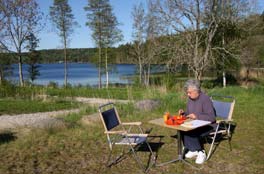 introductory sequence to the BBC adaptation of Robert
Graves' I Claudius, for those readers old and wise enough to recall the
time long ago when the BBC truly earned its licence fee by producing quality
drama (Photo 35 - Adder slithering over Högsbyn rock art).
Our photographic attention was divided between the prehistoric mysterious
art-work and the beautiful wild flora covering the ground among the rocks. introductory sequence to the BBC adaptation of Robert
Graves' I Claudius, for those readers old and wise enough to recall the
time long ago when the BBC truly earned its licence fee by producing quality
drama (Photo 35 - Adder slithering over Högsbyn rock art).
Our photographic attention was divided between the prehistoric mysterious
art-work and the beautiful wild flora covering the ground among the rocks.
Högsbyn Fritidscenter, another delightful campsite:
this
had been a thoroughly absorbing walk on a beautiful sunny
afternoon in peaceful solitude, and less than a km drive
around a side lane led us to tonight's campsite,
Högsbyn Fritidscenter. The lane led down to the shore of
Lake Råvarpen where flat camping areas were terraced up the
hillside, and we found a perfect spot looking out SW
directly across the lake with the afternoon sunlight
sparkling across the water above dark spruce trees on the
far side of the lake. This was a gem of a site and we gladly
settled in, revelling in this peaceful Dalsland setting,
enjoying the late afternoon sunshine with the only
sound being the waterfall of the stream tumbling down the
hillside behind us and the birdsong - sheer heaven (Photo 36 - Late afternoon sun at lakeside Högsbyn Camping).
Our 2013 trip to Sweden has got off to a rewarding
start. Next week will take us further into Central Sweden to Värmland and the
cities of Karlstad and Örebro, to the former iron mining region of Bergslagen at
Nora and Falun, and north to Mora and Lake Siljan. This lovely country is so full of interest
with so
much to discover, that our web reporting is
already beginning to fall behind schedule. No surprises there, and no apologies
needed. Be patient. Our next edition will follow soon, so add the site to your Favourites and join us again then.
Next edition
to be published quite soon
|
Sheila and Paul |
Published: 28 June 2013 at
Sorsele |
|
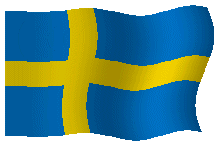
 CAMPING
IN SWEDEN 2013 - Skåne, Göteborg, the Bohuslän Coast, and inland to Trollhättan, Lake Vänern
and Dalsland:
CAMPING
IN SWEDEN 2013 - Skåne, Göteborg, the Bohuslän Coast, and inland to Trollhättan, Lake Vänern
and Dalsland:
 The interior with its sturdy
Romanesque rounded arches is dominated by the chancel's huge apse whose dome is
decorated with gilded mosaics of Christ in Glory (Photo 5 - Lund Cathedral apse with gilded mosaics).
Down in the gloomy crypt, 2 of the pillars supporting the chancel above are
gripped by stone figures: the legend is that Finn the Giant built the cathedral
for St Lawrence demanding the saint's eyes in payment unless the saint could
guess his name. The canny saint however overheard the giant's wife boast to her
child of Father Finn's gift of eyes to play with; the giant, his wife and child rushed into
the crypt to pull down the columns but were turned to stone. It's a good yarn,
and they are still they to be seen clutching the pillars. Up in the nave, the 1440s
astronomical clock with its complex of dials plays In Dulce
Jubilo as the clock strikes 3-00 and a procession of Wise Men carved figures parades around
the Virgin and Child.
The interior with its sturdy
Romanesque rounded arches is dominated by the chancel's huge apse whose dome is
decorated with gilded mosaics of Christ in Glory (Photo 5 - Lund Cathedral apse with gilded mosaics).
Down in the gloomy crypt, 2 of the pillars supporting the chancel above are
gripped by stone figures: the legend is that Finn the Giant built the cathedral
for St Lawrence demanding the saint's eyes in payment unless the saint could
guess his name. The canny saint however overheard the giant's wife boast to her
child of Father Finn's gift of eyes to play with; the giant, his wife and child rushed into
the crypt to pull down the columns but were turned to stone. It's a good yarn,
and they are still they to be seen clutching the pillars. Up in the nave, the 1440s
astronomical clock with its complex of dials plays In Dulce
Jubilo as the clock strikes 3-00 and a procession of Wise Men carved figures parades around
the Virgin and Child. was founded in 1666 after the 1658 crucial Treaty of Roskilde
had finally ceded the SW corner of the country to Sweden from Danish control.
The university developed in the 19th century with the establishment of new
Chairs, an increase in student numbers and women admitted as early as the 1880s. In 1900
there were 1000 students at Lund; today it is one of Scandinavia's largest
institutions of higher education and research with over 47,000 students. Inside
the university building we were able to get a look at the magnificent
assembly aula where degree ceremonies are held (see left).
was founded in 1666 after the 1658 crucial Treaty of Roskilde
had finally ceded the SW corner of the country to Sweden from Danish control.
The university developed in the 19th century with the establishment of new
Chairs, an increase in student numbers and women admitted as early as the 1880s. In 1900
there were 1000 students at Lund; today it is one of Scandinavia's largest
institutions of higher education and research with over 47,000 students. Inside
the university building we were able to get a look at the magnificent
assembly aula where degree ceremonies are held (see left).  Helsingborg, port for cross-Öresund ferries: 30kms north we reached
the industrial port of Helsingborg planning to stay at Råå Vallar Camping, yet
another wretched holiday-camp where we were greeted in an unwelcoming and
officious manner: it was one of those places with so many offensively
restrictive regulations, you did not know which one to break first, an expensive
and inhospitable place to be avoided. The following morning we drove down to the harbour from where
ferries chug back and forth across the Öresund carrying Swedes across to
Helsingør on the Danish side to buy cheaper alcohol (see right). But today the
Danish shore was scarcely visible in miserable misty rain.
We sat by the yacht marina looking across to Helsingborg's Kulturhus, the city
Museum and Art Gallery designed by Kim Utzon, son of the Sydney Opera House
architect, but a rather less inspiring design. The Kulturhus was funded by the
foundation set up by Henry Dunkers, a Helsingborg industrialist who made his
fortune by perfecting the vulcanising process to make rubber boots, manufactured at the
Helsingborg Gummifabrik. The factory closed in 1979 but the name lives on in the
modernistic building by the city's waterfront. Rather more imposing is the
city's pompously Neo-Gothic Rådhus (town hall) which dominates the corner
Helsingborg, port for cross-Öresund ferries: 30kms north we reached
the industrial port of Helsingborg planning to stay at Råå Vallar Camping, yet
another wretched holiday-camp where we were greeted in an unwelcoming and
officious manner: it was one of those places with so many offensively
restrictive regulations, you did not know which one to break first, an expensive
and inhospitable place to be avoided. The following morning we drove down to the harbour from where
ferries chug back and forth across the Öresund carrying Swedes across to
Helsingør on the Danish side to buy cheaper alcohol (see right). But today the
Danish shore was scarcely visible in miserable misty rain.
We sat by the yacht marina looking across to Helsingborg's Kulturhus, the city
Museum and Art Gallery designed by Kim Utzon, son of the Sydney Opera House
architect, but a rather less inspiring design. The Kulturhus was funded by the
foundation set up by Henry Dunkers, a Helsingborg industrialist who made his
fortune by perfecting the vulcanising process to make rubber boots, manufactured at the
Helsingborg Gummifabrik. The factory closed in 1979 but the name lives on in the
modernistic building by the city's waterfront. Rather more imposing is the
city's pompously Neo-Gothic Rådhus (town hall) which dominates the corner
 opposite the ferry harbour (Photo 7 - Waterfront and Rådhus at Helsingborg).
The elongated main square of Stortorget leads uphill from the port to the
remains of Helsingborg's medieval castle, fought over for centuries until Sweden
finally gained control of Skåne from the Danes. The surviving castle keep of
Kärnan now serves as a landmark for mariners passing along the Öresund and
provides spectacular views down to the ferry harbour,
at least on a clear day which today wasn't! (Photo 8 - Öresund ferry from Helsinør entering Helsingborg harbour).
From the parklands surrounding Kärnan, a pathway lined with rhododendrons leads
down to Södra Storgatan in the old town and the Danish-Gothic basilica of Sancta
Maria kyrka. The red-brick 14th century church's plain exterior gives little
impression of its beautiful interior. Amid the imposing brick-archwork, the eye
is drawn to the gilded 1450 carved triptych, its 3 panels depicting scenes from
the life of Christ (see left).
opposite the ferry harbour (Photo 7 - Waterfront and Rådhus at Helsingborg).
The elongated main square of Stortorget leads uphill from the port to the
remains of Helsingborg's medieval castle, fought over for centuries until Sweden
finally gained control of Skåne from the Danes. The surviving castle keep of
Kärnan now serves as a landmark for mariners passing along the Öresund and
provides spectacular views down to the ferry harbour,
at least on a clear day which today wasn't! (Photo 8 - Öresund ferry from Helsinør entering Helsingborg harbour).
From the parklands surrounding Kärnan, a pathway lined with rhododendrons leads
down to Södra Storgatan in the old town and the Danish-Gothic basilica of Sancta
Maria kyrka. The red-brick 14th century church's plain exterior gives little
impression of its beautiful interior. Amid the imposing brick-archwork, the eye
is drawn to the gilded 1450 carved triptych, its 3 panels depicting scenes from
the life of Christ (see left). Kullaberg Peninsula Nature Reserve:
rising conspicuously above the flat surrounding farmland, the high wooded ridge
of the Kullaberg Peninsula was our next stop with a stay at First Camp
Möllehässle; despite the high price at what was another large holiday-camp, the
setting was pleasant with flat pitches terraced into the grassy slopes and more
importantly, a hospitable welcome; what a difference a smile makes! That evening
we enjoyed the trip's first barbecue (see right). Our reason however for coming here was a day's walking around the Kullaberg Nature
Reserve's cliff-top paths of the peninsula which projects into the Kattegat.
Kullaberg Peninsula Nature Reserve:
rising conspicuously above the flat surrounding farmland, the high wooded ridge
of the Kullaberg Peninsula was our next stop with a stay at First Camp
Möllehässle; despite the high price at what was another large holiday-camp, the
setting was pleasant with flat pitches terraced into the grassy slopes and more
importantly, a hospitable welcome; what a difference a smile makes! That evening
we enjoyed the trip's first barbecue (see right). Our reason however for coming here was a day's walking around the Kullaberg Nature
Reserve's cliff-top paths of the peninsula which projects into the Kattegat.
 Parking by the lighthouse at the tip of the peninsula, we set off around the
woodland path and were soon down on hands and knees photographing the banks of Spring wild flora, most
noticeably wood anemones (Photo 9 - Banks of
Wood Anemones at Kullaberg Nature Reserve).
Kullaberg's distinctive peninsula is an ancient east-west ridge of
erosion-resistant gneiss bedrock formed by the surrounding softer red sandstone
being eroded away and criss-crossed with fissure ravines along the coastlines.
The path undulated through the delightful birch woodland with occasional
glimpses of the sheer rocky cliffs. Across to the southern coastline among tall
birch trees whose bright green new leaf glowed in the sunlight, the return path
passed over more open heathland back to the lighthouse (see left) where the rocks at the
peninsula's tip gave misty views out across the Kattegat (Photo 10 - Misty Kattegat vista
from Kullaberg lighthouse).
Parking by the lighthouse at the tip of the peninsula, we set off around the
woodland path and were soon down on hands and knees photographing the banks of Spring wild flora, most
noticeably wood anemones (Photo 9 - Banks of
Wood Anemones at Kullaberg Nature Reserve).
Kullaberg's distinctive peninsula is an ancient east-west ridge of
erosion-resistant gneiss bedrock formed by the surrounding softer red sandstone
being eroded away and criss-crossed with fissure ravines along the coastlines.
The path undulated through the delightful birch woodland with occasional
glimpses of the sheer rocky cliffs. Across to the southern coastline among tall
birch trees whose bright green new leaf glowed in the sunlight, the return path
passed over more open heathland back to the lighthouse (see left) where the rocks at the
peninsula's tip gave misty views out across the Kattegat (Photo 10 - Misty Kattegat vista
from Kullaberg lighthouse). Göteborg,
Sweden's second city: a 200km drive up the E6 motorway brought us to
Sweden's second city, Göteborg (pronounced Yerteboy). The city's only
campsites are both run by the horrendous Liseberg Amusement Park, both of them huge
holiday-camps charging outrageously extortionate prices for the dubious
privilege of staying there. We did however want to visit Göteborg and chose the
marginally lower priced Askim Strand Camping some 12kms out of the city down at
the coast. The young staff however were welcoming and helpful, giving us
details of the Rosa Express buses into the city centre and the bus stop 15
minutes walk away. The following morning, we set off to catch the bus,
following the journey on the street plan we had been given to get off at the
city's Central Railway Station. Göteborg was
founded at the mouth of the Göta River in 1621 by King Gustav II Adolphus. With
the South-West of the country securely in Swedish control from the Danes after
1658, the port-city developed as a major trading post bypassing the extortionate Öresund tolls charged by the Danish and so attracting British, Dutch and German
merchants. In the 18/19th centuries it
Göteborg,
Sweden's second city: a 200km drive up the E6 motorway brought us to
Sweden's second city, Göteborg (pronounced Yerteboy). The city's only
campsites are both run by the horrendous Liseberg Amusement Park, both of them huge
holiday-camps charging outrageously extortionate prices for the dubious
privilege of staying there. We did however want to visit Göteborg and chose the
marginally lower priced Askim Strand Camping some 12kms out of the city down at
the coast. The young staff however were welcoming and helpful, giving us
details of the Rosa Express buses into the city centre and the bus stop 15
minutes walk away. The following morning, we set off to catch the bus,
following the journey on the street plan we had been given to get off at the
city's Central Railway Station. Göteborg was
founded at the mouth of the Göta River in 1621 by King Gustav II Adolphus. With
the South-West of the country securely in Swedish control from the Danes after
1658, the port-city developed as a major trading post bypassing the extortionate Öresund tolls charged by the Danish and so attracting British, Dutch and German
merchants. In the 18/19th centuries it
 became the base for Swedish trade with
the Far East monopolised by the Swedish East India Company, and continues as a
major cosmopolitan port-city today with a population of over 500,000.
became the base for Swedish trade with
the Far East monopolised by the Swedish East India Company, and continues as a
major cosmopolitan port-city today with a population of over 500,000. speaking staff in the TIC answered our questions with helpful
efficiency, adding to our stock of Swedish language for good measure. Following
the embankment of the Rosenlunds-kanalen, the former moat of the original
fortified city, we walked around past the buildings of Göteborg University where
city trams trundled to and fro across the bridge (Photo 11 - Göteborg tram crossing Rosenlunds-kanalen).
Nearby we came to Stora Saluhallen, a grand barrel-roofed structure dating from
the 1880s housing the city's wonderful indoor market (see left). Now regular
readers of our travels will know that ambling around markets is one of our
favourite pastimes, and Göteborg Saluhallen did not disappoint (Photo 12 - Göteborg's Stora Saluhallen market-hall).
This was a busy and wonderfully atmospheric market and we happily browsed the
butchery, vegetable and cheese stalls along with local shoppers; the
appetising food stalls were an obvious lunch venue for good value bowls of tasty
speaking staff in the TIC answered our questions with helpful
efficiency, adding to our stock of Swedish language for good measure. Following
the embankment of the Rosenlunds-kanalen, the former moat of the original
fortified city, we walked around past the buildings of Göteborg University where
city trams trundled to and fro across the bridge (Photo 11 - Göteborg tram crossing Rosenlunds-kanalen).
Nearby we came to Stora Saluhallen, a grand barrel-roofed structure dating from
the 1880s housing the city's wonderful indoor market (see left). Now regular
readers of our travels will know that ambling around markets is one of our
favourite pastimes, and Göteborg Saluhallen did not disappoint (Photo 12 - Göteborg's Stora Saluhallen market-hall).
This was a busy and wonderfully atmospheric market and we happily browsed the
butchery, vegetable and cheese stalls along with local shoppers; the
appetising food stalls were an obvious lunch venue for good value bowls of tasty
 fish-soup. Göteborg's indoor 1874
fish-market, the Feskekörka, is an attractive curiosity resembling externally a
Neo-Gothic church (see right). The only worship here however is of fish, fish
and more fish, stalls laden with every kind of fish and shellfish; it was a
sight and smell to delight any fish-loving palate (Photo 13 - Feskekôrka indoor fish market).
fish-soup. Göteborg's indoor 1874
fish-market, the Feskekörka, is an attractive curiosity resembling externally a
Neo-Gothic church (see right). The only worship here however is of fish, fish
and more fish, stalls laden with every kind of fish and shellfish; it was a
sight and smell to delight any fish-loving palate (Photo 13 - Feskekôrka indoor fish market). Passing
all the trendy and overpriced bars and restaurants along the wide boulevard of
Avenyn, we followed the regally named Vasa-gatan to a park by the church of
Hagakyrka and the memorial to Raoul Wallenberg, the Swedish businessman-diplomat
who rescued 1000s of Hungarian Jews from certain death at German hands in 1944
and who mysteriously disappeared after the 1945 Soviet 'liberation' of Budapest.
Youngsters lolled on the grass or played ball games, indifferent to the
distinctive monolith engraved with Wallenberg's portrait and small figures of
Jewish victims squatting forlornly at the base of the memorial (see left).
Returning through the parkland opposite the university where students picnicked
on the grass beside the canal, we walked up Västra Hamngatan to Göteborg Cathedral,
the Domkyrkan (see right). The original church was built soon after Gustav II Adolphus' foundation of the city and was dedicated in 1633 as the diocesan
cathedral of Western Sweden. The present church dating from 1827 is the third on
the site, the first 2 having been destroyed by fires; fronted at the west end
portico by 4 huge sandstone columns, the beige exterior brickwork is matched by
even more starkly plain Lutheran interior. The only concession to adornment is
the ornately gilded post-resurrection empty cross with Christ's grave clothes
scattered around.
Passing
all the trendy and overpriced bars and restaurants along the wide boulevard of
Avenyn, we followed the regally named Vasa-gatan to a park by the church of
Hagakyrka and the memorial to Raoul Wallenberg, the Swedish businessman-diplomat
who rescued 1000s of Hungarian Jews from certain death at German hands in 1944
and who mysteriously disappeared after the 1945 Soviet 'liberation' of Budapest.
Youngsters lolled on the grass or played ball games, indifferent to the
distinctive monolith engraved with Wallenberg's portrait and small figures of
Jewish victims squatting forlornly at the base of the memorial (see left).
Returning through the parkland opposite the university where students picnicked
on the grass beside the canal, we walked up Västra Hamngatan to Göteborg Cathedral,
the Domkyrkan (see right). The original church was built soon after Gustav II Adolphus' foundation of the city and was dedicated in 1633 as the diocesan
cathedral of Western Sweden. The present church dating from 1827 is the third on
the site, the first 2 having been destroyed by fires; fronted at the west end
portico by 4 huge sandstone columns, the beige exterior brickwork is matched by
even more starkly plain Lutheran interior. The only concession to adornment is
the ornately gilded post-resurrection empty cross with Christ's grave clothes
scattered around. We continued north to Stenpiren (Stone Pier)
overlooking the wide Göta River with the city port's cranes lining the far bank.
Here on the quayside stands the Delaware Monument, a replica of the memorial set
up in America to the first Swedish emigrants who set off from here to find a new
life in 'New Sweden' on the banks of the Delaware River in 1638 (see left). Many 1000s of
Swedish emigrants followed fleeing the famines of the 19th century. Along the
embankment of Norra Hamngatan, we passed the Stadmuseum housed in what was once
the HQ and customs house of the Swedish East India Company whose affluence was
based on its monopolistic mercantile rights with the Far East on condition that
all its trading goods were auctioned here in Göteborg. The port-city also
prospered from this until competition from British and Dutch tea and spice
traders broke the monopoly. Just beyond we reached Gustav Adolfs
We continued north to Stenpiren (Stone Pier)
overlooking the wide Göta River with the city port's cranes lining the far bank.
Here on the quayside stands the Delaware Monument, a replica of the memorial set
up in America to the first Swedish emigrants who set off from here to find a new
life in 'New Sweden' on the banks of the Delaware River in 1638 (see left). Many 1000s of
Swedish emigrants followed fleeing the famines of the 19th century. Along the
embankment of Norra Hamngatan, we passed the Stadmuseum housed in what was once
the HQ and customs house of the Swedish East India Company whose affluence was
based on its monopolistic mercantile rights with the Far East on condition that
all its trading goods were auctioned here in Göteborg. The port-city also
prospered from this until competition from British and Dutch tea and spice
traders broke the monopoly. Just beyond we reached Gustav Adolfs  Torg, where
the city founder's grand statue stood in the centre of His Square; imperiously he
pointed to the spot where he wished his new city to be built - Right here, His
Majesty declared. Apparently the original statue commissioned from Germany was
kidnapped on its way to Sweden; rather than pay the ransom, the city merchant-venturers
simply ordered a new one, and here it stood in its eponymous square waiting to
be photographed (Photo 14 - Göteborg's founder King Gustav II Adolphus).
Torg, where
the city founder's grand statue stood in the centre of His Square; imperiously he
pointed to the spot where he wished his new city to be built - Right here, His
Majesty declared. Apparently the original statue commissioned from Germany was
kidnapped on its way to Sweden; rather than pay the ransom, the city merchant-venturers
simply ordered a new one, and here it stood in its eponymous square waiting to
be photographed (Photo 14 - Göteborg's founder King Gustav II Adolphus). Kungälv
- Bohus Fästning medieval fortress, and a good campsite at last: we moved 12 kms north to the small town of Kungälv
where, on an island between the Rivers Göta and Nordre, Bohus Fästning
(Fortress) was built in 1308 by King Håkon V Magnusson of Norway to guard what
was then the southern border of his realm at its meeting point with the medieval
kingdoms of Sweden and Denmark. It was one of the mightiest castles in the Nordic lands, besieged 14 times but
never taken, and standing below its formidable walls, you could understand why.
Occupied by both the Norwegians and Danes during the first 350 years of its
existence
Kungälv
- Bohus Fästning medieval fortress, and a good campsite at last: we moved 12 kms north to the small town of Kungälv
where, on an island between the Rivers Göta and Nordre, Bohus Fästning
(Fortress) was built in 1308 by King Håkon V Magnusson of Norway to guard what
was then the southern border of his realm at its meeting point with the medieval
kingdoms of Sweden and Denmark. It was one of the mightiest castles in the Nordic lands, besieged 14 times but
never taken, and standing below its formidable walls, you could understand why.
Occupied by both the Norwegians and Danes during the first 350 years of its
existence
 as
both a military stronghold and royal palace, it finally became Swedish under the
1658 Treaty of Roskilde. By the end of the 18th century with its military
significance past, troops were withdrawn and the castle abandoned; locals from Kungälv
plundered the ruins for building stone. Restoration began in the late 19th
century when the castle's historical worth was recognised. Its imposing remains
stand to this day and we spent the afternoon scrambling around the preserved
ruins of the fortress round tower and ramparts (see left) (Photo 16 - 14th century fortress at Kungälv).
Immediately opposite, we found tonight's base, the Kungälvs Vandrarhem (hostel)
and Camping (see right), a hospitable and straightforward little campsite in a
splendid riverbank setting overshadowed by Bohus castle. It had everything that
other campsites used so far had lacked: a peaceful setting free from noisy
holiday-makers, a lovely welcome, free wi-fi internet and very reasonable price,
a real little gem of a site. And we only discovered afterwards that Kungälv,
just 12 kms north of Göteborg, is also on a regular express bus route into the
city; we could have made our visit to Göteborg from here, staying at Kungälvs
Vandrarhem for almost half the price of the unsavoury Liseberg Askim Strand.
as
both a military stronghold and royal palace, it finally became Swedish under the
1658 Treaty of Roskilde. By the end of the 18th century with its military
significance past, troops were withdrawn and the castle abandoned; locals from Kungälv
plundered the ruins for building stone. Restoration began in the late 19th
century when the castle's historical worth was recognised. Its imposing remains
stand to this day and we spent the afternoon scrambling around the preserved
ruins of the fortress round tower and ramparts (see left) (Photo 16 - 14th century fortress at Kungälv).
Immediately opposite, we found tonight's base, the Kungälvs Vandrarhem (hostel)
and Camping (see right), a hospitable and straightforward little campsite in a
splendid riverbank setting overshadowed by Bohus castle. It had everything that
other campsites used so far had lacked: a peaceful setting free from noisy
holiday-makers, a lovely welcome, free wi-fi internet and very reasonable price,
a real little gem of a site. And we only discovered afterwards that Kungälv,
just 12 kms north of Göteborg, is also on a regular express bus route into the
city; we could have made our visit to Göteborg from here, staying at Kungälvs
Vandrarhem for almost half the price of the unsavoury Liseberg Askim Strand.
 The Bohuslän
Coast - Marstrand: on
a rainy, blustery morning with a chill westerly wind blowing off the sea, we
drove out to the Bohuslän Coast, crossing causeways and an elegantly arched bridge
connecting a chain of islets ending at the island of Koön where the chain-ferry
connected to the car-free off-shore island of Marstrand. Marstrands Familje
Camping 1km inland from the ferry was totally deserted in early May, but the
owner responded to our phone call with the barrier key code; thankful to be away
from overcrowded holiday-camps, we relished another sensibly priced, welcoming
and peaceful campsite in a lovely rural setting and with free internet. A
peculiar Swedish dietary habit is their passion for meat balls (köttbullar), and
that evening as a warming antidote to the driving rain and cutting wind, we cooked our
first sample of köttbullar in tomato sauce with spaghetti, doubtless not the
Swedish way but it has now become our way! The following morning, we crossed by
The Bohuslän
Coast - Marstrand: on
a rainy, blustery morning with a chill westerly wind blowing off the sea, we
drove out to the Bohuslän Coast, crossing causeways and an elegantly arched bridge
connecting a chain of islets ending at the island of Koön where the chain-ferry
connected to the car-free off-shore island of Marstrand. Marstrands Familje
Camping 1km inland from the ferry was totally deserted in early May, but the
owner responded to our phone call with the barrier key code; thankful to be away
from overcrowded holiday-camps, we relished another sensibly priced, welcoming
and peaceful campsite in a lovely rural setting and with free internet. A
peculiar Swedish dietary habit is their passion for meat balls (köttbullar), and
that evening as a warming antidote to the driving rain and cutting wind, we cooked our
first sample of köttbullar in tomato sauce with spaghetti, doubtless not the
Swedish way but it has now become our way! The following morning, we crossed by the little ferry which chugs back and forth across the narrow sound separating Marstrand from its neighbouring island, for the 6km walk around Marstrand's
shore-side footpath. The crossing takes just a couple of minutes, and in warm
clothes and full waterproofs against the chill wind, we set off along the
waterfront passing the little harbour's wooden houses which might have looked so
attractive in fine weather. But the Nordic gods were smiling on us today and by
the time we left the town behind and headed around the rocky coastline, the
cloud was starting to break. Being a safe and ice-free port, Marstrand had once
prospered from the herring-fishing
industry, but the herring disappeared taking with them the island's source of
prosperity. In the 19th century Marstrand's wooden fish-salting
the little ferry which chugs back and forth across the narrow sound separating Marstrand from its neighbouring island, for the 6km walk around Marstrand's
shore-side footpath. The crossing takes just a couple of minutes, and in warm
clothes and full waterproofs against the chill wind, we set off along the
waterfront passing the little harbour's wooden houses which might have looked so
attractive in fine weather. But the Nordic gods were smiling on us today and by
the time we left the town behind and headed around the rocky coastline, the
cloud was starting to break. Being a safe and ice-free port, Marstrand had once
prospered from the herring-fishing
industry, but the herring disappeared taking with them the island's source of
prosperity. In the 19th century Marstrand's wooden fish-salting
 sheds were
converted into bathing houses and the little port re-invented itself as a fashionable
bathing resort. Today the port attracts the affluent yachting hoards in summer
but in early May the town was a quiet sleepy place with the harbour side
restaurants just beginning to prepare for summer influx of tourists. The
footpath sloped up past glorious banks of cowslips (see right) onto the cliff-tops
overlooking the sound with a side path branching down through a narrow squeeze
in high rocks, and we wound a slippery way among the rocks to the craggy
shore-line where eider ducks bobbed in the water with their characteristic 'oo-ing'
sound and terns flitted overhead making their piercing alarm calls. As we
rounded the island's western tip with its small lighthouse, the sun miraculously
broke through but with the SW wind still blowing briskly chill
(Photo 17 - Marstrand's rocky shoreline). We
followed the path over the shore-side rocks revelling in the glorious light
sparkling across the sea (see left), eventually completing the circuit back into the
southern end of Marstrand town by the sound to walk along the harbour front past
the wooden houses (Photo 18 - Wooden houses along Marstrand's waterfront).
We joined local people returning by the ferry across the sound, and walked back
to camp after such a glorious day's walk around Marstrand's rocky shore.
sheds were
converted into bathing houses and the little port re-invented itself as a fashionable
bathing resort. Today the port attracts the affluent yachting hoards in summer
but in early May the town was a quiet sleepy place with the harbour side
restaurants just beginning to prepare for summer influx of tourists. The
footpath sloped up past glorious banks of cowslips (see right) onto the cliff-tops
overlooking the sound with a side path branching down through a narrow squeeze
in high rocks, and we wound a slippery way among the rocks to the craggy
shore-line where eider ducks bobbed in the water with their characteristic 'oo-ing'
sound and terns flitted overhead making their piercing alarm calls. As we
rounded the island's western tip with its small lighthouse, the sun miraculously
broke through but with the SW wind still blowing briskly chill
(Photo 17 - Marstrand's rocky shoreline). We
followed the path over the shore-side rocks revelling in the glorious light
sparkling across the sea (see left), eventually completing the circuit back into the
southern end of Marstrand town by the sound to walk along the harbour front past
the wooden houses (Photo 18 - Wooden houses along Marstrand's waterfront).
We joined local people returning by the ferry across the sound, and walked back
to camp after such a glorious day's walk around Marstrand's rocky shore. Island of Tjörn and Fishing village of
Klädesholmen: the following morning, we re-crossed the bridge and
causeways linking the islets of the archipelago, over the elegant bridge linking
to the larger Bohuslän island of Tjörn. Down at the island's SW tip we reached
the large fishing village of Klädesholmen spread across 2 interconnected
off-shore islets. Klädesholmen was also once a major herring fishing port with
30 fish-processing factories as described in the Herring Museum; but with the
disappearance of the herring, only a fraction of the former industry survives.
Former fishermen's cottages and sheds have now been converted to twee
residences, but the village is still a charming place. We spent a peacefully
contented afternoon wandering around the lanes and alleyways, with views between
white-painted cottages and red-painted former fishing sheds over small
anchorages out to the distant islands of the archipelago (Photo 19 - Fishing village of Klädesholmen on Tjörn island).
Across a small bridge connecting to Klädesholmen's outer islet, we continued
along Fiskhamnväg over a hillock down to the tiny harbour of Västra Hamn. Here
around the anchorage working fishing boats and smaller craft were moored (see
right). Not
only was this a peaceful and attractive setting among all the boats, looking
across the water to the white-painted cottages and church on the headland
opposite, of equal interest to us was the sheltered parking area by the
guest-harbour's toilets-showers: here was a perfect spot for tonight's camp. The
harbour-master was agreeable charging us 150kr as for the gästhamn, and we
settled in tucked behind a large rocky outcrop looking out over the boats in the
harbour and cottages across the bay; it was a truly beautiful spot to camp (Photo 20 - Camp at Klädesholmen's Västra Hamn fishing harbour).
Island of Tjörn and Fishing village of
Klädesholmen: the following morning, we re-crossed the bridge and
causeways linking the islets of the archipelago, over the elegant bridge linking
to the larger Bohuslän island of Tjörn. Down at the island's SW tip we reached
the large fishing village of Klädesholmen spread across 2 interconnected
off-shore islets. Klädesholmen was also once a major herring fishing port with
30 fish-processing factories as described in the Herring Museum; but with the
disappearance of the herring, only a fraction of the former industry survives.
Former fishermen's cottages and sheds have now been converted to twee
residences, but the village is still a charming place. We spent a peacefully
contented afternoon wandering around the lanes and alleyways, with views between
white-painted cottages and red-painted former fishing sheds over small
anchorages out to the distant islands of the archipelago (Photo 19 - Fishing village of Klädesholmen on Tjörn island).
Across a small bridge connecting to Klädesholmen's outer islet, we continued
along Fiskhamnväg over a hillock down to the tiny harbour of Västra Hamn. Here
around the anchorage working fishing boats and smaller craft were moored (see
right). Not
only was this a peaceful and attractive setting among all the boats, looking
across the water to the white-painted cottages and church on the headland
opposite, of equal interest to us was the sheltered parking area by the
guest-harbour's toilets-showers: here was a perfect spot for tonight's camp. The
harbour-master was agreeable charging us 150kr as for the gästhamn, and we
settled in tucked behind a large rocky outcrop looking out over the boats in the
harbour and cottages across the bay; it was a truly beautiful spot to camp (Photo 20 - Camp at Klädesholmen's Västra Hamn fishing harbour).  The Bohuslän islands of Orust and Malö, and fishing port of Mollösund:
moving north, we crossed a further bridge across the narrow sound separating Tjörn
from Sweden's 3rd largest island, Orust. The central part of Orust was
surprisingly wooded with spectacular rocky outcrops and cleared farmland in the
areas between. At the end of a long inlet at the SW tip of the island, we
reached the small fishing port of Mollösund, clearly not a place to visit in
summer when the tiny village and harbour would be overwhelmed with
tourists. In mid-May the delightful place was deserted and we were able to park
right by the harbour-side where a few boats were moored (see left). Again we spent a happy
afternoon ambling around the harbour and fishing-processing factories, and the
cobbled lanes between the cottages and anchorages (Photo 21 - harbour-village
of Mollösund on Orust).
How many of these, we wondered were occupied by working residents rather than
holiday homes for city dwellers from Göteborg? We were told of a small campsite
on the further island of Malö, and expecting to cross by another bridge, we were
surprised when the road descended to the intervening sound ending at a barrier
and red traffic light for a small car-ferry. The ferry waited for the bus on the
far shore and we crossed without charge to Malö. After a night's camp, we
crossed the tiny island of Malö with its stunningly beautiful terrain of rocky
outcrops, passing farmsteads and tiny inlets with boats moored, for the
car-ferry linking back to the long mainland peninsula that extends out
into the Bohuslän archipelago to Fiskebäckskils (Photo 22 - Car ferry from Malö back to Bokenäs peninsula).
The Bohuslän islands of Orust and Malö, and fishing port of Mollösund:
moving north, we crossed a further bridge across the narrow sound separating Tjörn
from Sweden's 3rd largest island, Orust. The central part of Orust was
surprisingly wooded with spectacular rocky outcrops and cleared farmland in the
areas between. At the end of a long inlet at the SW tip of the island, we
reached the small fishing port of Mollösund, clearly not a place to visit in
summer when the tiny village and harbour would be overwhelmed with
tourists. In mid-May the delightful place was deserted and we were able to park
right by the harbour-side where a few boats were moored (see left). Again we spent a happy
afternoon ambling around the harbour and fishing-processing factories, and the
cobbled lanes between the cottages and anchorages (Photo 21 - harbour-village
of Mollösund on Orust).
How many of these, we wondered were occupied by working residents rather than
holiday homes for city dwellers from Göteborg? We were told of a small campsite
on the further island of Malö, and expecting to cross by another bridge, we were
surprised when the road descended to the intervening sound ending at a barrier
and red traffic light for a small car-ferry. The ferry waited for the bus on the
far shore and we crossed without charge to Malö. After a night's camp, we
crossed the tiny island of Malö with its stunningly beautiful terrain of rocky
outcrops, passing farmsteads and tiny inlets with boats moored, for the
car-ferry linking back to the long mainland peninsula that extends out
into the Bohuslän archipelago to Fiskebäckskils (Photo 22 - Car ferry from Malö back to Bokenäs peninsula). Back inland to Lake
Vänern and Halleberg-Hunneberg Plateau Nature
Reserve: the following morning's drive back inland would involve the
whole spectrum of roads, starting on the peaceful single-track rural lane across Malö,
minor roads, and finally the busy Route 44 motorway past Uddevalla to Vänersborg.
Our impression so far was that Swedish drivers were generally patient and
considerate, drove at speed when sensible but observed speed limits faithfully
without the aggressive overtaking, tail-gating and cutting in that now bedevils
driving in UK. Beyond Vänersborg, we crossed the wide River Göta which exits
from the inland-sea of Lake Vänern to flow as the Göta Canal down to Göteborg.
Leaving the main road, we took a winding minor road gaining height onto the
thickly wooded rocky Hunneberg Plateau. We knew of walks around the nature
reserve but needed a detailed map from the museum at the former royal hunting
lodge here. The elderly gent here charmed us with tales of Hunneberg's
history, culture and
Back inland to Lake
Vänern and Halleberg-Hunneberg Plateau Nature
Reserve: the following morning's drive back inland would involve the
whole spectrum of roads, starting on the peaceful single-track rural lane across Malö,
minor roads, and finally the busy Route 44 motorway past Uddevalla to Vänersborg.
Our impression so far was that Swedish drivers were generally patient and
considerate, drove at speed when sensible but observed speed limits faithfully
without the aggressive overtaking, tail-gating and cutting in that now bedevils
driving in UK. Beyond Vänersborg, we crossed the wide River Göta which exits
from the inland-sea of Lake Vänern to flow as the Göta Canal down to Göteborg.
Leaving the main road, we took a winding minor road gaining height onto the
thickly wooded rocky Hunneberg Plateau. We knew of walks around the nature
reserve but needed a detailed map from the museum at the former royal hunting
lodge here. The elderly gent here charmed us with tales of Hunneberg's
history, culture and
 geology, when all we wanted was a map and details of walks.
We did however learn that the 2 plateaux of Hunneberg/Halleberg had originally
been one plug of hard erosion-resistant rock created by the intrusion of magma
into the softer surrounding bedrock which had over time eroded leaving the
resistant plateau exposed with its sheer craggy cliff-edges rising 50m above the
surrounding plain and Lake Vänern. The plateau had been cleaved by tectonic
movement leaving a valley separating the 2 now distinct plateaux. Armed with our
map, we followed a lane up onto the northern wooded plateau of Halleberg to its
northern end. A path led to the plateau's eastern cliff-edge looking out across
over the inland sea of Lake Vänern which faded into the misty distance to the NE
with no trace of land (Photo 23 - Inland sea of Lake Vänern from Halleberg plateau).
We followed the nature reserve circular way-marked path around the cliffs of the
plateau's northern tip through the original oak and spruce forest, but it was
the delightful woodland flora that made this walk so memorable, particularly the
carpets of wood anemones (see left), occasional hepatica, wood sorrel, bilberry with its
bright green new leaf and tiny pink globular flowers, and patches of
distinctive lingonberry leaves, covering the woodland floor. At the northern
tip, another lookout point above the plateau's lofty cliff edge gave views out
across Lake Vänern (see right). This was a truly magical woodland walk especially in bright
afternoon sunshine.
geology, when all we wanted was a map and details of walks.
We did however learn that the 2 plateaux of Hunneberg/Halleberg had originally
been one plug of hard erosion-resistant rock created by the intrusion of magma
into the softer surrounding bedrock which had over time eroded leaving the
resistant plateau exposed with its sheer craggy cliff-edges rising 50m above the
surrounding plain and Lake Vänern. The plateau had been cleaved by tectonic
movement leaving a valley separating the 2 now distinct plateaux. Armed with our
map, we followed a lane up onto the northern wooded plateau of Halleberg to its
northern end. A path led to the plateau's eastern cliff-edge looking out across
over the inland sea of Lake Vänern which faded into the misty distance to the NE
with no trace of land (Photo 23 - Inland sea of Lake Vänern from Halleberg plateau).
We followed the nature reserve circular way-marked path around the cliffs of the
plateau's northern tip through the original oak and spruce forest, but it was
the delightful woodland flora that made this walk so memorable, particularly the
carpets of wood anemones (see left), occasional hepatica, wood sorrel, bilberry with its
bright green new leaf and tiny pink globular flowers, and patches of
distinctive lingonberry leaves, covering the woodland floor. At the northern
tip, another lookout point above the plateau's lofty cliff edge gave views out
across Lake Vänern (see right). This was a truly magical woodland walk especially in bright
afternoon sunshine. Trollhättan with its dam sluice-gate
waterfalls and excellent campsite: we joined the afternoon traffic on the
main road running alongside the Halleberg Plateau, with the 50m cliffs of its
western edge catching the afternoon sun, into the outskirts of Trollhättan, an
industrial town which developed on the banks of the Göta River/Canal. At the
town's campsite, we were welcomed with smilingly genuine hospitality; tired
after a long day, you could not have asked for a more kindly welcome: nothing
was too much trouble, showing an empathic understanding towards weary travellers
and giving us a street plan and directions for our visit to Trollhättan and the
best location for seeing the town's weekly spectacle, the opening of the sluice
gates on the Göta River dam which creates magnificent waterfalls. You are our
guests he said, a lesson which so many other campsite could usefully follow. For
a city campsite, 15 minutes' walk from the centre, the setting was delightfully
wooded, and the facilities spotlessly clean and modern. This really was a first
class and well-run campsite (see right). We later learnt that the Saab motor manufacturer
had had its main assembly plant here at Trollhättan but the firm had gone bust
and the plant, the town's largest employer had closed 2 years ago with the loss
of 4,000 jobs
Trollhättan with its dam sluice-gate
waterfalls and excellent campsite: we joined the afternoon traffic on the
main road running alongside the Halleberg Plateau, with the 50m cliffs of its
western edge catching the afternoon sun, into the outskirts of Trollhättan, an
industrial town which developed on the banks of the Göta River/Canal. At the
town's campsite, we were welcomed with smilingly genuine hospitality; tired
after a long day, you could not have asked for a more kindly welcome: nothing
was too much trouble, showing an empathic understanding towards weary travellers
and giving us a street plan and directions for our visit to Trollhättan and the
best location for seeing the town's weekly spectacle, the opening of the sluice
gates on the Göta River dam which creates magnificent waterfalls. You are our
guests he said, a lesson which so many other campsite could usefully follow. For
a city campsite, 15 minutes' walk from the centre, the setting was delightfully
wooded, and the facilities spotlessly clean and modern. This really was a first
class and well-run campsite (see right). We later learnt that the Saab motor manufacturer
had had its main assembly plant here at Trollhättan but the firm had gone bust
and the plant, the town's largest employer had closed 2 years ago with the loss
of 4,000 jobs
 and 3,000 further jobs in associates industries. What a blow this
must have been for a small community.
and 3,000 further jobs in associates industries. What a blow this
must have been for a small community. The
day's highlight was to be the opening of the HEP dam's sluice
gates creating 2 enormous waterfalls in the Göta gorge which during the
non-summer months only happens once a week at 3-00pm on Saturdays; our visit to Trollhättan
had been timed to coincide with this spectacle. The footpath ran through
parkland along an embankment separating the river's wide natural course from the
maintained canal still widely used by both commercial cargo shipping and pleasure
craft. At the centre of the town, the river's natural course and the modern,
artificially cut canal parted company. We continued ahead along the canal
embankment to reach an electrical distribution station close to one of the HEP
generating plants. Here we cut across the Oskarbron, a high lofty modern
bridge spanning the 150 feet deep craggy river gorge, now totally dry with the
river dammed for the nearby Hojums HEP generating plant.
The
day's highlight was to be the opening of the HEP dam's sluice
gates creating 2 enormous waterfalls in the Göta gorge which during the
non-summer months only happens once a week at 3-00pm on Saturdays; our visit to Trollhättan
had been timed to coincide with this spectacle. The footpath ran through
parkland along an embankment separating the river's wide natural course from the
maintained canal still widely used by both commercial cargo shipping and pleasure
craft. At the centre of the town, the river's natural course and the modern,
artificially cut canal parted company. We continued ahead along the canal
embankment to reach an electrical distribution station close to one of the HEP
generating plants. Here we cut across the Oskarbron, a high lofty modern
bridge spanning the 150 feet deep craggy river gorge, now totally dry with the
river dammed for the nearby Hojums HEP generating plant.
 From here, although we
could not see the lake retained by the 2 dams to create the head of water to
drive the generating plants turbines, we did have a perfect view 800m upstream
of the dam's sluice gates which would be opened to create the waterfalls spectacle filling the now dry gorge 150 feet below us. At 3-00pm a sudden
cascade of white water surged from the left-hand sluice gates snaking with
remarkable tardiness down into the rocky gorge and swelling out into a foaming
torrent. Equally suddenly, a similar torrent gushed from the other sluice
surging slowly down into the gorge bed to merge with the first to form one mass
of water advancing down into the dry bed. All of this seemed to happen in slow
motion taking a full 4 minutes from when the 2 sluices were opened to when the
merged nose of white water passed down the gorge's dry bed under the bridge
below us (Photos 24 & 25 - Start of Trollhättan waterfalls and merged torrent in full spate).
We stood in astonishment on the bridge gazing down at this remarkable spectacle.
From here, although we
could not see the lake retained by the 2 dams to create the head of water to
drive the generating plants turbines, we did have a perfect view 800m upstream
of the dam's sluice gates which would be opened to create the waterfalls spectacle filling the now dry gorge 150 feet below us. At 3-00pm a sudden
cascade of white water surged from the left-hand sluice gates snaking with
remarkable tardiness down into the rocky gorge and swelling out into a foaming
torrent. Equally suddenly, a similar torrent gushed from the other sluice
surging slowly down into the gorge bed to merge with the first to form one mass
of water advancing down into the dry bed. All of this seemed to happen in slow
motion taking a full 4 minutes from when the 2 sluices were opened to when the
merged nose of white water passed down the gorge's dry bed under the bridge
below us (Photos 24 & 25 - Start of Trollhättan waterfalls and merged torrent in full spate).
We stood in astonishment on the bridge gazing down at this remarkable spectacle. But
that was not the end of our appreciation of the industrial exploitation of the Göta
River; there was now the remarkable story of the Canal's development and the
problems facing its designers in engineering a navigable passage to bypass this
formidable obstacle of the Göta's 150 feet deep gorge. Earlier attempts to
achieve this had been foiled by technological inadequacies. But in 1844, enter
one Nils Ericson (1802~70), civil engineer extraordinary and Sweden's equivalent
of I K Brunel. He had been responsible for construction of the Saimaa Canal in
what was then Swedish Finland which we had travelled on last year to the now
Russian port of Vyborg. In order to bypass the Göta River's insurmountable
natural course, Ericson had to blast out an entirely new channel from the bed
rock parallel with but some distance from the river's natural course; there was
then the problem of lowering the new cut down the 150 feet drop in order for boats to
rejoin the river downstream of the gorge. Ericson achieved this with a long
series of locks (slussar) which we now walked to see (see right). The current
navigable channel was impressively wide and the on-going series of locks
continued for some distance from the top lock towards the lower river. A walk
back on the footpath alongside Ericson's canal cut further impressed us with the
creativity of this remarkable engineer who went on to develop the entire Swedish
national railway system. Before leaving we walked around to the lake retained
behind the dam; the footbridge spanning the dam gave a breath-taking impression
of the height loss in the river's gorge which Ericson's canal had to drop by
means of the flight of locks. We plodded wearily back to camp after such an
inspiring day of discovery, understanding more about Trollhättan's remarkable
industrial heritage and the twin exploitation of the Göta River both for canal
navigation and HEP generation. It is always the sign of a good campsite when you
are sorry to be leaving, and we had enjoyed an excellent stay here at
Trollhättan Camping.
But
that was not the end of our appreciation of the industrial exploitation of the Göta
River; there was now the remarkable story of the Canal's development and the
problems facing its designers in engineering a navigable passage to bypass this
formidable obstacle of the Göta's 150 feet deep gorge. Earlier attempts to
achieve this had been foiled by technological inadequacies. But in 1844, enter
one Nils Ericson (1802~70), civil engineer extraordinary and Sweden's equivalent
of I K Brunel. He had been responsible for construction of the Saimaa Canal in
what was then Swedish Finland which we had travelled on last year to the now
Russian port of Vyborg. In order to bypass the Göta River's insurmountable
natural course, Ericson had to blast out an entirely new channel from the bed
rock parallel with but some distance from the river's natural course; there was
then the problem of lowering the new cut down the 150 feet drop in order for boats to
rejoin the river downstream of the gorge. Ericson achieved this with a long
series of locks (slussar) which we now walked to see (see right). The current
navigable channel was impressively wide and the on-going series of locks
continued for some distance from the top lock towards the lower river. A walk
back on the footpath alongside Ericson's canal cut further impressed us with the
creativity of this remarkable engineer who went on to develop the entire Swedish
national railway system. Before leaving we walked around to the lake retained
behind the dam; the footbridge spanning the dam gave a breath-taking impression
of the height loss in the river's gorge which Ericson's canal had to drop by
means of the flight of locks. We plodded wearily back to camp after such an
inspiring day of discovery, understanding more about Trollhättan's remarkable
industrial heritage and the twin exploitation of the Göta River both for canal
navigation and HEP generation. It is always the sign of a good campsite when you
are sorry to be leaving, and we had enjoyed an excellent stay here at
Trollhättan Camping. North towards the Norwegian border and the
Tanum-Vitlycke Bronze Age rock engravings: the E6 motorway northwards
passing through increasingly spectacular terrain of wooded hills, with
occasional glimpses of coastal fjords and sensational viaducts spanning broad
valleys. We turned off
North towards the Norwegian border and the
Tanum-Vitlycke Bronze Age rock engravings: the E6 motorway northwards
passing through increasingly spectacular terrain of wooded hills, with
occasional glimpses of coastal fjords and sensational viaducts spanning broad
valleys. We turned off
 onto
a minor road leading to the Tanum-Vitlycke Museum which we hoped would provide interpretation of the prehistoric rock engravings around Tanum
to supplement the Rock Carvings Tour booklet bought at the North Bohusläs
Museum in Uddevalla. The
panels of rock art around North Bohuslän dating from the mid-late Bronze Age
around 1500~500 BC were chiselled onto flat panels of bed-rock granite using
flint tools. At that time, sea levels were higher than today so that most of the
panels were along fjord shore-lines. Unlike the Neolithic nomadic hunter-gathers
who had created the ritual engravings at Alta in North Norway seen by us last
year, the Tanum rock art was created by a more settled agricultural culture who
supplemented their pastoral existence keeping sheep, pigs and cattle and working
the land to grow barley and rye, with hunting in the surrounding forests. Bronze
was bartered from Europe for skins and local produce, and smelted for weapons
and ceremonial ornaments. The carved rock figures supported by archaeological
finds show a continuity of occupation and land use for over 1000 years. There
are 4 areas of rock engravings, and the panel at Tanum-Vitlycke was clearly
visible on the opposite hillside. As at Alta, the figures engraved on the flat
granite panels had controversially been coloured in with red paint to make them
more visible to modern day visitors (Photo 26 - Tanum Bronze Age rock engravings from 1500~500 BC).
Although difficult to interpret, the art-work of some 300 human and animal
figures, boats and other symbols is thought to represent religious ceremonial
ritual, fertility rites and representation of the passage from life to death.
The
best-known figures are a male-female pairing known as 'The Lovers' engaged
in an obvious human act but with a warrior figure holding an axe above the
onto
a minor road leading to the Tanum-Vitlycke Museum which we hoped would provide interpretation of the prehistoric rock engravings around Tanum
to supplement the Rock Carvings Tour booklet bought at the North Bohusläs
Museum in Uddevalla. The
panels of rock art around North Bohuslän dating from the mid-late Bronze Age
around 1500~500 BC were chiselled onto flat panels of bed-rock granite using
flint tools. At that time, sea levels were higher than today so that most of the
panels were along fjord shore-lines. Unlike the Neolithic nomadic hunter-gathers
who had created the ritual engravings at Alta in North Norway seen by us last
year, the Tanum rock art was created by a more settled agricultural culture who
supplemented their pastoral existence keeping sheep, pigs and cattle and working
the land to grow barley and rye, with hunting in the surrounding forests. Bronze
was bartered from Europe for skins and local produce, and smelted for weapons
and ceremonial ornaments. The carved rock figures supported by archaeological
finds show a continuity of occupation and land use for over 1000 years. There
are 4 areas of rock engravings, and the panel at Tanum-Vitlycke was clearly
visible on the opposite hillside. As at Alta, the figures engraved on the flat
granite panels had controversially been coloured in with red paint to make them
more visible to modern day visitors (Photo 26 - Tanum Bronze Age rock engravings from 1500~500 BC).
Although difficult to interpret, the art-work of some 300 human and animal
figures, boats and other symbols is thought to represent religious ceremonial
ritual, fertility rites and representation of the passage from life to death.
The
best-known figures are a male-female pairing known as 'The Lovers' engaged
in an obvious human act but with a warrior figure holding an axe above the
 bonding couple's heads (see right). Another
figure portrayed a warrior wearing a horned helmet and travelling in a 2-wheeled
horse-drawn chariot;
the
nearby snake-like emblem is thought to represent a
lightning bolt and the charioteer perhaps an pre-cursor
bonding couple's heads (see right). Another
figure portrayed a warrior wearing a horned helmet and travelling in a 2-wheeled
horse-drawn chariot;
the
nearby snake-like emblem is thought to represent a
lightning bolt and the charioteer perhaps an pre-cursor of the Nordic god of
thunder Thor (see left). There were also a number of boat figures thought
ritually to represent the passage from this life to the kingdom of the dead. In the centre of the panel was a unique depiction of a female figure
(distinguishable by her plaited hair) mourning a dead male (see left)
of the Nordic god of
thunder Thor (see left). There were also a number of boat figures thought
ritually to represent the passage from this life to the kingdom of the dead. In the centre of the panel was a unique depiction of a female figure
(distinguishable by her plaited hair) mourning a dead male (see left) staying
that night at the small Tanums Camping, but found it closed. The only
alternative was one of the over-crowded and uninviting holiday-camps down at the
coast, the least unappealing of which, Saltviks Camping, enjoys the
distinction of being one of the most memorably disgusting campsites we have ever
had the misfortune to use, as well as over-pricey; the inhospitable
owner could not even be bothered to open the office, nor did we feel inclined to
part with kroner for such an unpleasant stay, and the following morning
thankfully hastened away to continue our journey northward.
staying
that night at the small Tanums Camping, but found it closed. The only
alternative was one of the over-crowded and uninviting holiday-camps down at the
coast, the least unappealing of which, Saltviks Camping, enjoys the
distinction of being one of the most memorably disgusting campsites we have ever
had the misfortune to use, as well as over-pricey; the inhospitable
owner could not even be bothered to open the office, nor did we feel inclined to
part with kroner for such an unpleasant stay, and the following morning
thankfully hastened away to continue our journey northward. predominantly Norwegian traffic was far more aggressive and less tolerant than
Swedish drivers. Thankful to be leaving the motorway, we turned off on a quiet
lane to Blomholmens Säteris (manor house), the estate where the Blomsholm
Stenskeppet (Stone Ship) Iron Age burial mound is located. As we approached, the
standing stones forming the sip's outline could be seen topping a low hillock
across the fields. 49 standing stones arranged in the shape of a long boat, 41m
long and 9m wide with bow and stern stones 3m high (Photo 28 - Strömstad 'Stone Ship' Iron Age burial mound). Although it is the largest
such boat-grave in Sweden, little is known of its history. It is thought to date
from the late Iron Age, between 500~1000 AD, when sea levels were higher than
now and the lower ground near the grave would have been the shore-line of an
inlet from the sea. Boats clearly were of ritual importance to prehistoric
northern peoples as the rock art had shown, symbolising the passage from life to
death. Although the hillock forming tumulus beneath the stone-circle has never
been excavated, it is assumed that it marks a grave and the size of the monument
indicates an important chieftain. We had seen such smaller stone-ships in
Northern Jutland which once would have been buried under soil; this one however
was never covered and was designed to be visible from the shallow bay it
overlooked. Clearly this was an impressive monument even 1,500 years after it
received its VIP burial.
predominantly Norwegian traffic was far more aggressive and less tolerant than
Swedish drivers. Thankful to be leaving the motorway, we turned off on a quiet
lane to Blomholmens Säteris (manor house), the estate where the Blomsholm
Stenskeppet (Stone Ship) Iron Age burial mound is located. As we approached, the
standing stones forming the sip's outline could be seen topping a low hillock
across the fields. 49 standing stones arranged in the shape of a long boat, 41m
long and 9m wide with bow and stern stones 3m high (Photo 28 - Strömstad 'Stone Ship' Iron Age burial mound). Although it is the largest
such boat-grave in Sweden, little is known of its history. It is thought to date
from the late Iron Age, between 500~1000 AD, when sea levels were higher than
now and the lower ground near the grave would have been the shore-line of an
inlet from the sea. Boats clearly were of ritual importance to prehistoric
northern peoples as the rock art had shown, symbolising the passage from life to
death. Although the hillock forming tumulus beneath the stone-circle has never
been excavated, it is assumed that it marks a grave and the size of the monument
indicates an important chieftain. We had seen such smaller stone-ships in
Northern Jutland which once would have been buried under soil; this one however
was never covered and was designed to be visible from the shallow bay it
overlooked. Clearly this was an impressive monument even 1,500 years after it
received its VIP burial. Strömstad Camping: we returned along the lane to negotiate the traffic queue
at the motorway junction, and on the outskirts of Strömstad pulled in at what we
thought was a shopping centre. But the predominance of Norwegian cars should
have alerted us that this was no conventional out-of-town supermarket. This was
hyper-greed at its very worst - cross-border trade where Norwegians swarmed
frantically in
their 1000s for cheap booze and consumer goods. Extricating ourselves from this
materialistic madness into Strömstad, we managed to park in the main street to
do our shopping at perfectly normal Co-op. Strömstad was a pleasant town: what had once been
a small fishing port had developed into a late 19th century spa town with the
main spa centre still dominating the marina. Ferries ran from here to the
off-shore Kosterhavet Islands, since 2009 protected as Sweden's first marine
national park. We were greeted at the local campsite with smiling hospitality
and a good value price of 210kr with no hidden extras and free wi-fi internet;
it was one of those campsites that recognises the sensible formula for success
of welcoming its guests as a hotel would. But the impressively distinctive
feature was the ingenious way it had managed somehow to implant flat and
extensive camping areas across the huge rocky outcrops of the broad headland on
which it was sited. We tucked ourselves into a secluded and sheltered corner
under a rocky outcrop overlooking the steep-sided valley of a fjord-inlet. This
was a magnificently unique spot in which to enjoy a day in camp (Photo 29 - Strömstad Camping on headland overlooking fjord-inlet).
Strömstad Camping: we returned along the lane to negotiate the traffic queue
at the motorway junction, and on the outskirts of Strömstad pulled in at what we
thought was a shopping centre. But the predominance of Norwegian cars should
have alerted us that this was no conventional out-of-town supermarket. This was
hyper-greed at its very worst - cross-border trade where Norwegians swarmed
frantically in
their 1000s for cheap booze and consumer goods. Extricating ourselves from this
materialistic madness into Strömstad, we managed to park in the main street to
do our shopping at perfectly normal Co-op. Strömstad was a pleasant town: what had once been
a small fishing port had developed into a late 19th century spa town with the
main spa centre still dominating the marina. Ferries ran from here to the
off-shore Kosterhavet Islands, since 2009 protected as Sweden's first marine
national park. We were greeted at the local campsite with smiling hospitality
and a good value price of 210kr with no hidden extras and free wi-fi internet;
it was one of those campsites that recognises the sensible formula for success
of welcoming its guests as a hotel would. But the impressively distinctive
feature was the ingenious way it had managed somehow to implant flat and
extensive camping areas across the huge rocky outcrops of the broad headland on
which it was sited. We tucked ourselves into a secluded and sheltered corner
under a rocky outcrop overlooking the steep-sided valley of a fjord-inlet. This
was a magnificently unique spot in which to enjoy a day in camp (Photo 29 - Strömstad Camping on headland overlooking fjord-inlet). Inland to Dalsland and the Håverud Aqueduct: glad to be getting
away from rowdy Norwegians in their ludicrous mega-buses (this was not camping
but sordid materialism-on-wheels), today we should finally leave the Bohuslän
Coast and turn inland through a corner of southern Norway on minor roads through
forested and increasingly hilly terrain, to return inland to Dalsland and the
north shore of Lake Vänern. Re-crossing into Sweden onto Route 166, the terrain
was reminiscent of Finland with dense spruce and birch forests, much timber
cutting and the roads busy with timber trucks. The guest-harbour municipal
campsite provided a delightful base for our stay at Håverud on the shore of Lake
Övre Upperudshöljen, the first of a long series of linked linear lakes forming
the Dalsland Canal. The campsite was just 5 minutes' walk from the lower canal
basin, though at this stage we were still bewildered by the canal's upward
progress through its flight of 4 locks and aqueduct at Håverud, and the problems
caused by this peculiar topography for the canal builders in bypassing the
sheer-sided gorge and river-rapids down the 10m height difference between the
upper and lower lakes. Our time at Håverud was to teach us much. On the
afternoon of our arrival, we got our first impressions of the scale of this
engineering wonder as walked up the towpath past the flight of locks, under the
narrow metal railway bridge which spans the gorge overhead (see right), and across the
walkway of the riveted steel trough aqueduct, to watch a tourist boat returning
across the aqueduct and down through the locks. That evening in camp, we tried
to piece together our understanding of what we had seen of the aqueduct, but
there were still so many unanswered questions about the building of the canal
and the cargoes transported.
Inland to Dalsland and the Håverud Aqueduct: glad to be getting
away from rowdy Norwegians in their ludicrous mega-buses (this was not camping
but sordid materialism-on-wheels), today we should finally leave the Bohuslän
Coast and turn inland through a corner of southern Norway on minor roads through
forested and increasingly hilly terrain, to return inland to Dalsland and the
north shore of Lake Vänern. Re-crossing into Sweden onto Route 166, the terrain
was reminiscent of Finland with dense spruce and birch forests, much timber
cutting and the roads busy with timber trucks. The guest-harbour municipal
campsite provided a delightful base for our stay at Håverud on the shore of Lake
Övre Upperudshöljen, the first of a long series of linked linear lakes forming
the Dalsland Canal. The campsite was just 5 minutes' walk from the lower canal
basin, though at this stage we were still bewildered by the canal's upward
progress through its flight of 4 locks and aqueduct at Håverud, and the problems
caused by this peculiar topography for the canal builders in bypassing the
sheer-sided gorge and river-rapids down the 10m height difference between the
upper and lower lakes. Our time at Håverud was to teach us much. On the
afternoon of our arrival, we got our first impressions of the scale of this
engineering wonder as walked up the towpath past the flight of locks, under the
narrow metal railway bridge which spans the gorge overhead (see right), and across the
walkway of the riveted steel trough aqueduct, to watch a tourist boat returning
across the aqueduct and down through the locks. That evening in camp, we tried
to piece together our understanding of what we had seen of the aqueduct, but
there were still so many unanswered questions about the building of the canal
and the cargoes transported.
 A visit to the Canal Museum down by the canal basin answered many of our
questions about the canal's history, its construction, the cargoes it carried,
the employment it brought, and its impact on the lives of those living along its
length. Iron ore mining and smelting had developed on an increasing scale during
the 17~early 19th centuries along the lakes of the remote regions of Dalsland
and Värmland, with pig iron transported by boat where rivers were navigable or
by carts along bumpy tracks. The Swedish parliament had eventually voted to fund
construction of a canal linking the elongated series of lakes to create a 250km
long waterway system between Töcksfors and the roadless wastes of Dalsland and
Lake Vänern. This was not a complex task since nature had done most of the work:
it required just 12 kms of canal cutting to connect the lakes and 31 locks to
overcome the 66m height difference between Lakes Stora Le and Vänern, to provide
a main commercial route for both raw materials and finished products for the
developing industry along the canal and daily needs of the growing population.
But the sting in the tail was at Håverud: here the 500m long river connecting
Lakes Åkläng and Övre Upperudshöljen dropped 10m down impassable rapids in a
sheer-side 500m narrow, precipitous gorge. Normal locks could not be constructed
on the loose rock in such ground conditions. The obstacle seemed insurmountable,
and lesser engineers considered alternative solutions. But again enter Nils
Ericson who was given responsibility for the project of overcoming the obstacle
at Håverud. Ericson, a remarkable engineer, much respected for his other
achievements including the work to bypass the gorge at Trollhättan, conceived a
brilliantly far-sighted and audacious solution. The problem at Håverud in the
confined, sheer-sided gorge was more complex than at Trollhättan: despite the
narrow gorge, Ericson however managed to squeeze his new cut alongside the river
falls with an artificial 'shelf' chopped into the gorge side-face on the inner
A visit to the Canal Museum down by the canal basin answered many of our
questions about the canal's history, its construction, the cargoes it carried,
the employment it brought, and its impact on the lives of those living along its
length. Iron ore mining and smelting had developed on an increasing scale during
the 17~early 19th centuries along the lakes of the remote regions of Dalsland
and Värmland, with pig iron transported by boat where rivers were navigable or
by carts along bumpy tracks. The Swedish parliament had eventually voted to fund
construction of a canal linking the elongated series of lakes to create a 250km
long waterway system between Töcksfors and the roadless wastes of Dalsland and
Lake Vänern. This was not a complex task since nature had done most of the work:
it required just 12 kms of canal cutting to connect the lakes and 31 locks to
overcome the 66m height difference between Lakes Stora Le and Vänern, to provide
a main commercial route for both raw materials and finished products for the
developing industry along the canal and daily needs of the growing population.
But the sting in the tail was at Håverud: here the 500m long river connecting
Lakes Åkläng and Övre Upperudshöljen dropped 10m down impassable rapids in a
sheer-side 500m narrow, precipitous gorge. Normal locks could not be constructed
on the loose rock in such ground conditions. The obstacle seemed insurmountable,
and lesser engineers considered alternative solutions. But again enter Nils
Ericson who was given responsibility for the project of overcoming the obstacle
at Håverud. Ericson, a remarkable engineer, much respected for his other
achievements including the work to bypass the gorge at Trollhättan, conceived a
brilliantly far-sighted and audacious solution. The problem at Håverud in the
confined, sheer-sided gorge was more complex than at Trollhättan: despite the
narrow gorge, Ericson however managed to squeeze his new cut alongside the river
falls with an artificial 'shelf' chopped into the gorge side-face on the inner
 side and buttressed by outer side by an man-made wall above the falls. But his
pièce do résistance was to span the gorge itself with a 32.5m long steel trough
aqueduct to link the 2 sections of his new cut along which conventional locks
could manage the 10m height drop between the upper and lower lakes. This
brilliant design concept won approval. Sections of the steel trough were
fabricated in Stockholm and assembled on site to be slid into position bridging
the gorge in the most confined space above the rapids. The sections were joined
by some 33,000 rivets, and such was the craftsmanship that not one has needed
replacement. Construction of the Dalsland Canal lasted 4 years 1868 and it was
officially opened on 19 September 1868 by King Carl XV. Despite the brilliance
of Ericson's solution for overcoming the Håverud obstacle, the Dalsland Canal
was short-lived as a commercial trade route. Within decades Sweden's late-built
railways caught up fast, and the line through Dalsland, ironically passing over
Ericson's aqueduct on the steel trestle bridge (see right), quickly took over the transport
of goods and materials, leaving the canal to pleasure boats and holiday craft.
side and buttressed by outer side by an man-made wall above the falls. But his
pièce do résistance was to span the gorge itself with a 32.5m long steel trough
aqueduct to link the 2 sections of his new cut along which conventional locks
could manage the 10m height drop between the upper and lower lakes. This
brilliant design concept won approval. Sections of the steel trough were
fabricated in Stockholm and assembled on site to be slid into position bridging
the gorge in the most confined space above the rapids. The sections were joined
by some 33,000 rivets, and such was the craftsmanship that not one has needed
replacement. Construction of the Dalsland Canal lasted 4 years 1868 and it was
officially opened on 19 September 1868 by King Carl XV. Despite the brilliance
of Ericson's solution for overcoming the Håverud obstacle, the Dalsland Canal
was short-lived as a commercial trade route. Within decades Sweden's late-built
railways caught up fast, and the line through Dalsland, ironically passing over
Ericson's aqueduct on the steel trestle bridge (see right), quickly took over the transport
of goods and materials, leaving the canal to pleasure boats and holiday craft. The following morning, from the modern road bridge high above
the village, we had a perfect aerial panorama of the entire setting of the
river's natural course down the gorge, the canal with its 4 locks overcoming the
height difference, the railway bridge passing over the whole ensemble, and of
course Ericson's aqueduct elegantly centre stage spanning the gorge (Photo 30 - Håverud Aqueduct carrying the Dalsland Canal over the river gorge).
The natural and man-made marvels were spread out below us, and from this vantage
point we watched the pleasure boat work its way up through the locks and slowly
advance across the aqueduct (see right) (Photo 31 - Boat crossing the Håverud Aqueduct).
From the other side of the bridge, we had a similar aerial view of the boat
passing along Ericson's shelf cut, out through the upper lock and out into Lake Åkläng
and pick up speed into the misty distance. We followed a foot path down under
the
The following morning, from the modern road bridge high above
the village, we had a perfect aerial panorama of the entire setting of the
river's natural course down the gorge, the canal with its 4 locks overcoming the
height difference, the railway bridge passing over the whole ensemble, and of
course Ericson's aqueduct elegantly centre stage spanning the gorge (Photo 30 - Håverud Aqueduct carrying the Dalsland Canal over the river gorge).
The natural and man-made marvels were spread out below us, and from this vantage
point we watched the pleasure boat work its way up through the locks and slowly
advance across the aqueduct (see right) (Photo 31 - Boat crossing the Håverud Aqueduct).
From the other side of the bridge, we had a similar aerial view of the boat
passing along Ericson's shelf cut, out through the upper lock and out into Lake Åkläng
and pick up speed into the misty distance. We followed a foot path down under
the railway bridge to reach the tow path and crossed the narrow metal walkway above
the 2m deep trough of the aqueduct (see right) (Photo 32 - Walkway across Håverud Aqueduct).
Standing here so matter of factly, the brilliance of the aqueduct's visionary
conception and the skill of its construction might so easily be taken for
granted. From this position, we had a closer appreciation of the sturdily
buttressed artificially-constructed wall which contained the outer side of
Ericson's wide shelf to contain the canal's on-going passage on the far side of
the aqueduct (see left). We continued ahead above the river's rocky natural
gorge to the sluice gates through which water cascaded to control water levels
according to traffic through the canal locks. Crossing the canal on the
lock-gates enabled us to examine how the shelf had been cut out of the gorge's
sheer rock face, where drill marks from the original blasting showed the scale
of construction required. A memorial plaque on the rock wall commemorated Nils
Ericson as designer and his son Werner who had superintended construction.
railway bridge to reach the tow path and crossed the narrow metal walkway above
the 2m deep trough of the aqueduct (see right) (Photo 32 - Walkway across Håverud Aqueduct).
Standing here so matter of factly, the brilliance of the aqueduct's visionary
conception and the skill of its construction might so easily be taken for
granted. From this position, we had a closer appreciation of the sturdily
buttressed artificially-constructed wall which contained the outer side of
Ericson's wide shelf to contain the canal's on-going passage on the far side of
the aqueduct (see left). We continued ahead above the river's rocky natural
gorge to the sluice gates through which water cascaded to control water levels
according to traffic through the canal locks. Crossing the canal on the
lock-gates enabled us to examine how the shelf had been cut out of the gorge's
sheer rock face, where drill marks from the original blasting showed the scale
of construction required. A memorial plaque on the rock wall commemorated Nils
Ericson as designer and his son Werner who had superintended construction. introductory sequence to the BBC adaptation of Robert
Graves' I Claudius, for those readers old and wise enough to recall the
time long ago when the BBC truly earned its licence fee by producing quality
drama (Photo 35 - Adder slithering over Högsbyn rock art).
Our photographic attention was divided between the prehistoric mysterious
art-work and the beautiful wild flora covering the ground among the rocks.
introductory sequence to the BBC adaptation of Robert
Graves' I Claudius, for those readers old and wise enough to recall the
time long ago when the BBC truly earned its licence fee by producing quality
drama (Photo 35 - Adder slithering over Högsbyn rock art).
Our photographic attention was divided between the prehistoric mysterious
art-work and the beautiful wild flora covering the ground among the rocks.